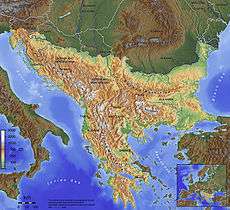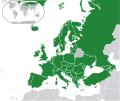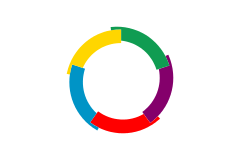Slovenia
Slovenia (/sloʊˈviːniə, slə-/ (![]()
![]()
Republic of Slovenia | |
|---|---|
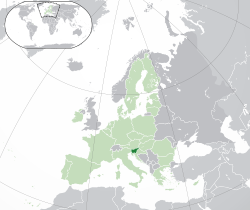 | |
| Capital and largest city | Ljubljana 46°03′N 14°30′E |
| Official languages | Slovene[lower-roman 1] |
| Recognised regional languages | Italian Hungarian |
| Ethnic groups | |
| Religion (2018)[3] |
|
| Demonym(s) | Slovene |
| Government | Unitary parliamentary constitutional republic |
| Borut Pahor | |
| Janez Janša | |
| Legislature | Parliament |
| National Council | |
| National Assembly | |
| Establishment | |
| 29 October 1918 | |
| 4 December 1918 | |
| 19 February 1944 | |
| 29 November 1945 | |
| 25 June 1991[4] | |
| 7 July 1991 | |
| 23 December 1991 | |
• Admitted to the United Nations | 22 May 1992 |
| 1 May 2004 | |
| Area | |
• Total | 20,271 km2 (7,827 sq mi) (151st) |
• Water (%) | 0.7[5] |
| Population | |
• 2020 estimate | |
• 2002 census | 1,964,036 |
• Density | 102[6]/km2 (264.2/sq mi) (106th) |
| GDP (PPP) | 2020 estimate |
• Total | $83 billion[7] (93rd) |
• Per capita | |
| GDP (nominal) | 2020 estimate |
• Total | $56 billion[7] (80th) |
• Per capita | |
| Gini (2019) | low |
| HDI (2018) | very high · 24th |
| Currency | Euro (€)[lower-roman 2] (EUR) |
| Time zone | UTC+1 (CET) |
| UTC+2 (CEST) | |
| Date format | dd. mm. yyyy (AD) |
| Driving side | right |
| Calling code | +386 |
| ISO 3166 code | SI |
| Internet TLD | .si[lower-roman 3] |
Website www | |
| |
It is bordered by Italy to the west, Austria to the north, Hungary to the northeast, Croatia to the southeast, and the Adriatic Sea to the southwest.[17] Slovenia covers 20,271 square kilometers (7,827 sq mi) and has a population of 2.095 million.[18] One of the successor states of the former Yugoslavia, Slovenia is now a parliamentary republic[19] and member nation of the European Union, United Nations, and NATO.[20] The capital and largest city is Ljubljana.[21]
Slovenia has a mostly mountainous terrain[22] with a mainly continental climate,[23] with the exception of the Slovene Littoral, which has a sub-Mediterranean climate, and of the Julian Alps in the northwest, which have an Alpine climate.[24] Additionally, the Dinaric Alps and the Pannonian Plain meet on the territory of Slovenia. The country, marked by significant biological diversity,[25][26] is one of the most water-rich in Europe,[27] with a dense river network, a rich aquifer system, and significant karst underground watercourses.[28] Over half of the territory is covered by forest.[29] The human settlement of Slovenia is dispersed and uneven.[30]
Slovenia has historically been the crossroads of Slavic, Germanic, and Romance languages and cultures.[31][32][33] Ethnic Slovenes comprise more than 80% of the population.[34] The South Slavic language Slovene is the official language throughout the country. Slovenia is a largely secularized country,[35] but Catholicism and Lutheranism have significantly influenced its culture and identity.[36] The economy of Slovenia is small, open and export-oriented and is thus strongly influenced by the conditions of its exporting partners' economies. This is especially true with Germany, Slovenia's biggest trade partner.[37] Like most of the developed world, Slovenia was severely hurt by the Eurozone crisis beginning in 2009, but started to recover in 2014.[38][39] The main economic driver for the country is the services industry, followed by manufacturing and construction.[40]
Historically, the territory of Slovenia has formed part of many different states, such as: the Roman Empire, Byzantine Empire, Carolingian Empire, the Holy Roman Empire, the Kingdom of Hungary, the Republic of Venice, the Illyrian Provinces of the First French Empire, the Austrian Empire and Austro-Hungarian Empire. In October 1918, the Slovenes exercised self-determination for the first time by co-founding the State of Slovenes, Croats and Serbs. In December 1918 they merged with the Kingdom of Serbia into the Kingdom of Serbs, Croats and Slovenes (renamed the Kingdom of Yugoslavia in 1929).
During World War II (1939–1945) Germany, Italy, and Hungary occupied and annexed the territories comprising today's Slovenia (1941–1945), with a tiny area transferred to the Independent State of Croatia, a Nazi puppet state.[41] In 1945 Slovenia became a founding member of the Federal People's Republic of Yugoslavia, renamed in 1963 as the Socialist Federal Republic of Yugoslavia. In the first years after World War II this state was initially allied with the Eastern Bloc, but because of the Tito-Stalin split in 1948 it never subscribed to the Warsaw Pact and in 1961 became one of the founders of the Non-Aligned Movement.
In June 1991, after the introduction of multi-party representative democracy, Slovenia became the first republic that split from Yugoslavia and became an independent sovereign state.[4] In 2004, it entered NATO and the European Union; in 2007 became the first formerly communist country to join the Eurozone;[42] and in 2010 it joined the OECD, a global association of high-income developed countries.[43] Slovenia is a developed country with an advanced, high-income economy[44][45] and a very high Human Development Index.[46] It ranks 12th in the inequality-adjusted human development index.
Etymology
Slovenia's name means the "Land of the Slavs" in Slovene and other South Slavic languages. It is thus a cognate of the words Slavonia, Slovakia and Slavia. The etymology of Slav itself remains uncertain.
The reconstructed autonym *Slověninъ is usually derived from the word slovo ("word"), originally denoting "people who speak (the same language)," i. e. people who understand each other. This is in contrast to the Slavic word denoting German people, namely *němьcь, meaning "silent, mute people" (from Slavic *němъ "mute, mumbling"). The word slovo ("word") and the related slava ("glory, fame") and slukh ("hearing") originate from the Proto-Indo-European root *ḱlew- ("be spoken of, glory"), cognate with Ancient Greek κλέος (kléos "fame"), as in the name Pericles, Latin clueo ("be called"), and English loud.
The modern Slovene state originates from the Slovene National Liberation Committee (SNOS) held on 19 February 1944. They officially named the state as Federal Slovenia (Federalna Slovenija), a unit within the Yugoslav federation. On 20 February 1946, Federal Slovenia was renamed the People's Republic of Slovenia (Ljudska republika Slovenija).[47] It retained this name until 9 April 1963, when its name was changed again, this time to Socialist Republic of Slovenia (Slovene: Socialistična republika Slovenija).[48] On 8 March 1990, SR Slovenia removed the prefix "Socialist" from its name, becoming the Republic of Slovenia; it remained a part of the SFRY until 25 June 1991.
| Date | Name | Notes |
|---|---|---|
| 1945–1946 | Federal Slovenia | Part of Democratic Federal Yugoslavia |
| 1946–1963 | People's Republic of Slovenia | Part of the Socialist Federal Republic of Yugoslavia |
| 1963–1990 | Socialist Republic of Slovenia | Part of the Socialist Federal Republic of Yugoslavia |
| 1990–present | Republic of Slovenia | Independent country from 1991 |
History
Prehistory to Slavic settlement
Prehistory
_(9420310527).jpg)
Present-day Slovenia has been inhabited since prehistoric times. There is evidence of human habitation from around 250,000 years ago.[49] A pierced cave bear bone, dating from 43100 ± 700 BP, found in 1995 in Divje Babe cave near Cerkno, is considered a kind of flute, and possibly the oldest musical instrument discovered in the world.[50] In the 1920s and 1930s, artifacts belonging to the Cro-Magnon, such as pierced bones, bone points, and a needle were found by archaeologist Srečko Brodar in Potok Cave.[51][52]
In 2002, remains of pile dwellings over 4,500 years old were discovered in the Ljubljana Marshes, now protected as a UNESCO World Heritage Site, along with the Ljubljana Marshes Wooden Wheel, the oldest wooden wheel in the world.[53] It shows that wooden wheels appeared almost simultaneously in Mesopotamia and Europe.[54] In the transition period between the Bronze Age to the Iron Age, the Urnfield culture flourished. Archaeological remains dating from the Hallstatt period have been found, particularly in southeastern Slovenia, among them a number of situlas in Novo Mesto, the "Town of Situlas".[55] In the Iron Age, present-day Slovenia was inhabited by Illyrian and Celtic tribes until the 1st century BC.
Roman era
.jpg)
The area that is present-day Slovenia was in Roman times shared between Venetia et Histria (region X of Roman Italia in the classification of Augustus) and the provinces Pannonia and Noricum. The Romans established posts at Emona (Ljubljana), Poetovio (Ptuj), and Celeia (Celje); and constructed trade and military roads that ran across Slovene territory from Italy to Pannonia. In the 5th and 6th centuries, the area was subject to invasions by the Huns and Germanic tribes during their incursions into Italy. A part of the inner state was protected with a defensive line of towers and walls called Claustra Alpium Iuliarum. A crucial battle between Theodosius I and Eugenius took place in the Vipava Valley in 394.[56][57]
Slavic settlement
The Slavic tribes migrated to the Alpine area after the westward departure of the Lombards (the last Germanic tribe) in 568, and under pressure from Avars established a Slavic settlement in the Eastern Alps. From 623 to 624 or possibly 626 onwards, King Samo united the Alpine and Western Slavs against the Avars and Germanic peoples and established what is referred to as Samo's Kingdom. After its disintegration following Samo's death in 658 or 659, the ancestors of the Slovenes located in present-day Carinthia formed the independent duchy of Carantania,[58] and Carniola, later duchy Carniola. Other parts of present-day Slovenia were again ruled by Avars before Charlemagne's victory over them in 803.

Middle Ages
The Carantanians, one of the ancestral groups of the modern Slovenes, particularly the Carinthian Slovenes, were the first Slavic people to accept Christianity. They were mostly Christianized by Irish missionaries, among them Modestus, known as the "Apostle of Carantanians". This process, together with the Christianization of the Bavarians, was later described in the memorandum known as the Conversio Bagoariorum et Carantanorum, which is thought to have overemphasized the role of the Church of Salzburg in the Christianization process over similar efforts of the Patriarchate of Aquileia.

In the mid-8th century, Carantania became a vassal duchy under the rule of the Bavarians, who began spreading Christianity. Three decades later, the Carantanians were incorporated, together with the Bavarians, into the Carolingian Empire. During the same period Carniola, too, came under the Franks, and was Christianised from Aquileia. Following the anti-Frankish rebellion of Liudewit at the beginning of the 9th century, the Franks removed the Carantanian princes, replacing them with their own border dukes. Consequently, the Frankish feudal system reached the Slovene territory.
After the victory of Emperor Otto I over the Magyars in 955, Slovene territory was divided into a number of border regions of the Holy Roman Empire. Carantania, being the most important, was elevated into the Duchy of Carinthia in 976.
By the 11th century, the Germanization of what is now Lower Austria, effectively isolated the Slovene-inhabited territory from the other western Slavs, speeding up the development of the Slavs of Carantania and of Carniola into an independent Carantanian/Carniolans/Slovene ethnic group. By the late Middle Ages, the historic provinces of Carniola, Styria, Carinthia, Gorizia, Trieste, and Istria developed from the border regions and were incorporated into the medieval German state. The consolidation and formation of these historical lands took place in a long period between the 11th and 14th centuries, and were led by a number of important feudal families, such as the Dukes of Spannheim, the Counts of Gorizia, the Counts of Celje, and, finally, the House of Habsburg. In a parallel process, an intensive German colonization significantly diminished the extent of Slovene-speaking areas. By the 15th century, the Slovene ethnic territory was reduced to its present size.[59]
In the 14th century, most of the territory of present-day Slovenia was taken over by the Habsburgs, the Hungarian clan Záh administering the territories connecting Slovenia with Slovakia and Moravia was exterminated in 1330 and the Slovenes permanently lost the connection with their Slovak kinsmen. The counts of Celje, a feudal family from this area who in 1436 acquired the title of state princes, were Habsburgs' powerful competitors for some time. This large dynasty, important at a European political level, had its seat in Slovene territory but died out in 1456. Its numerous large estates subsequently became the property of the Habsburgs, who retained control of the area right up until the beginning of the 20th century. Patria del Friuli ruled present western Slovenia until Venetian takeover in 1420.
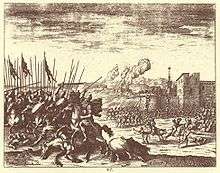
At the end of the Middle Ages, the Slovene Lands suffered a serious economic and demographic setback because of the Turkish raids. In 1515, a peasant revolt spread across nearly the whole Slovene territory. In 1572 and 1573 the Croatian-Slovenian peasant revolt wrought havoc throughout the wider region. Such uprisings, which often met with bloody defeats, continued throughout the 17th century.[59]
Early modern period
The Republic of Venice was dissolved by France and Venetian Slovenia was passed to the Austrian Empire in 1797. The Slovene Lands were part of the French-administered Illyrian provinces established by Napoleon, the Austrian Empire and Austria-Hungary. Slovenes inhabited most of Carniola, the southern part of the duchies of Carinthia and Styria, the northern and eastern areas of the Austrian Littoral, as well as Prekmurje in the Kingdom of Hungary.[60] Industrialization was accompanied by construction of railroads to link cities and markets, but the urbanization was limited.
Due to limited opportunities, between 1880 and 1910 there was extensive emigration, and around 300,000 Slovenes (i.e. 1 in 6) emigrated to other countries,[61] mostly to the US, but also to South America (the main part to Argentina), Germany, Egypt, and to larger cities in Austria-Hungary, especially Vienna and Graz. The area of the United States with the highest concentration of Slovenian immigrants is Cleveland, Ohio. The other locations in the United States where many Slovenians settled were areas with substantial industrial and mining activities: Pittsburgh, Chicago, Pueblo, Butte, northern Minnesota, and the Salt Lake Valley. The men were important as workers in the mining industry, because of some of the skills they brought from Slovenia. Despite this emigration, the population of Slovenia increased significantly.[61] Literacy was exceptionally high, at 80–90%.[61]
The 19th century also saw a revival of culture in the Slovene language, accompanied by a Romantic nationalist quest for cultural and political autonomy. The idea of a United Slovenia, first advanced during the revolutions of 1848, became the common platform of most Slovenian parties and political movements in Austria-Hungary. During the same period, Yugoslavism, an ideology stressing the unity of all South Slavic peoples, spread as a reaction to Pan-German nationalism and Italian irredentism.
World War I
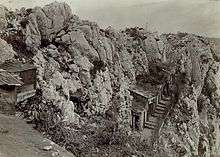
World War I brought heavy casualties to Slovenes, particularly the twelve Battles of the Isonzo, which took place in present-day Slovenia's western border area with Italy. Hundreds of thousands of Slovene conscripts were drafted into the Austro-Hungarian Army, and over 30,000 of them died. Hundreds of thousands of Slovenes from Gorizia and Gradisca were resettled in refugee camps in Italy and Austria. While the refugees in Austria received decent treatment, the Slovene refugees in Italian camps were treated as state enemies, and several thousand died of malnutrition and diseases between 1915 and 1918.[62] Entire areas of the Slovene Littoral were destroyed.
The Treaty of Rapallo of 1920 left approximately 327,000 out of the total population of 1.3 million Slovenes in Italy.[63][64] After the fascists took power in Italy, they were subjected to a policy of violent Fascist Italianization. This caused the mass emigration of Slovenes, especially the middle class, from the Slovenian Littoral and Trieste to Yugoslavia and South America. Those who remained organized several connected networks of both passive and armed resistance. The best known was the militant anti-fascist organization TIGR, formed in 1927 to fight Fascist oppression of the Slovene and Croat populations in the Julian March.[65][66]
Kingdom of Serbs, Croats, and Slovenes (later the Kingdom of Yugoslavia)
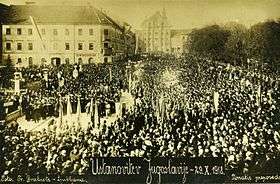
The Slovene People's Party launched a movement for self-determination, demanding the creation of a semi-independent South Slavic state under Habsburg rule. The proposal was picked up by most Slovene parties, and a mass mobilization of Slovene civil society, known as the Declaration Movement, followed.[67] This demand was rejected by the Austrian political elites; but following the dissolution of the Austro-Hungarian Empire in the aftermath of the First World War, the National Council of Slovenes, Croats and Serbs took power in Zagreb on 6 October 1918. On 29 October, independence was declared by a national gathering in Ljubljana, and by the Croatian parliament, declaring the establishment of the new State of Slovenes, Croats, and Serbs.
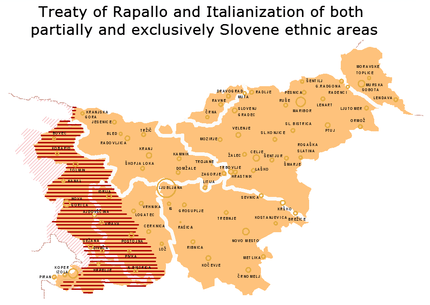
On 1 December 1918, the State of Slovenes, Croats and Serbs merged with Serbia, becoming part of the new Kingdom of Serbs, Croats, and Slovenes; in 1929 it was renamed the Kingdom of Yugoslavia. The main territory of Slovenia, being the most industrialized and westernized compared to other less developed parts of Yugoslavia, became the main center of industrial production: Compared to Serbia, for example, Slovenian industrial production was four times greater; and it was 22 times greater than in North Macedonia. The interwar period brought further industrialization in Slovenia, with rapid economic growth in the 1920s, followed by a relatively successful economic adjustment to the 1929 economic crisis and Great Depression.
Following a plebiscite in October 1920, the Slovene-speaking southern Carinthia was ceded to Austria. With the Treaty of Trianon, on the other hand, the Kingdom of Yugoslavia was awarded the Slovene-inhabited Prekmurje region, formerly part of Austro-Hungary.
Slovenes living in territories that fell under the rule of the neighboring states—Italy, Austria, and Hungary—were subjected to assimilation.
World War II
Slovenia was the only present-day European nation that was trisected and completely annexed into both Nazi Germany and Fascist Italy during World War II.[68] In addition, the Prekmurje region in the east was annexed to Hungary, and some villages in the Lower Sava Valley were incorporated in the newly created Nazi puppet Independent State of Croatia (NDH).
| During World War II, Nazi Germany and Hungary annexed northern areas (brown and dark green areas, respectively), while Fascist Italy annexed the vertically hashed black area (solid black western part having been annexed by Italy in 1920 with the Treaty of Rapallo). Some villages were incorporated into the Independent State of Croatia. After 1943, Germany took over the Italian occupational area, as well. |
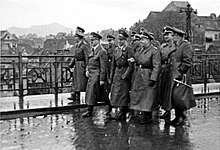
Axis forces invaded Yugoslavia in April 1941 and defeated the country in a few weeks. The southern part, including Ljubljana, was annexed to Italy, while the Nazis took over the northern and eastern parts of the country. The Nazis had a plan of ethnic cleansing of these areas,[69] and they resettled or expelled the local Slovene civilian population to the puppet states of Nedić's Serbia (7,500) and NDH (10,000). In addition, some 46,000 Slovenes were expelled to Germany, including children who were separated from their parents and allocated to German families.[70][71] At the same time, the ethnic Germans in the Gottschee enclave in the Italian annexation zone were resettled to the Nazi-controlled areas cleansed of their Slovene population.[72] Around 30,000 to 40,000 Slovene men were drafted to the German Army and sent to the Eastern front. The Slovene language was banned from education, and its use in public life was limited to the absolute minimum.[68]
In south-central Slovenia, annexed by Fascist Italy and renamed the Province of Ljubljana, the Slovenian National Liberation Front was organized in April 1941. Led by the Communist Party, it formed the Slovene Partisan units as part of the Yugoslav Partisans led by the Communist leader Josip Broz Tito.[73][74]
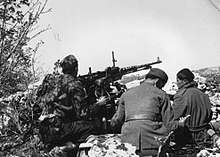
After the resistance started in summer 1941, Italian violence against the Slovene civilian population escalated, as well. The Italian authorities deported some 25,000 people to the concentration camps, which equaled 7.5% of the population of their occupation zone. The most infamous ones were Rab and Gonars. To counter the Communist-led insurgence, the Italians sponsored local anti-guerrilla units, formed mostly by the local conservative Catholic Slovene population that resented the revolutionary violence of the partisans. After the Italian armistice of September 1943, the Germans took over both the Province of Ljubljana and the Slovenian Littoral, incorporating them into what was known as the Operation Zone of Adriatic Coastal Region. They united the Slovene anti-Communist counter-insurgence into the Slovene Home Guard and appointed a puppet regime in the Province of Ljubljana. The anti-Nazi resistance however expanded, creating its own administrative structures as the basis for Slovene statehood within a new, federal and socialist Yugoslavia.[75][76]
In 1945, Yugoslavia was liberated by the partisan resistance and soon became a socialist federation known as the People's Federal Republic of Yugoslavia. Slovenia joined the federation as a constituent republic, led by its own pro-Communist leadership.
Approximately 8% of the entire Slovene population died during World War II. The small Jewish community, mostly settled in the Prekmurje region, perished in 1944 in the holocaust of Hungarian Jews. The German speaking minority, amounting to 2.5% of the Slovenian population prior to WWII, was either expelled or killed in the aftermath of the war. Hundreds of Istrian Italians and Slovenes that opposed communism were killed in the foibe massacres, and more than 25,000 fled or were expelled from Slovenian Istria in the aftermath of the war.[77]
Socialist period
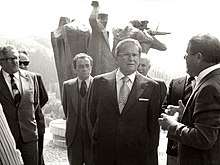
Following the re-establishment of Yugoslavia during World War II, Slovenia became part of Federal Yugoslavia. A socialist state was established, but because of the Tito–Stalin split in 1948, economic and personal freedoms were broader than in the Eastern Bloc countries. In 1947, the Slovene Littoral and the western half of Inner Carniola, which had been annexed by Italy after World War One, were annexed to Slovenia.
After the failure of forced collectivisation that was attempted from 1949 to 1953, a policy of gradual economic liberalisation, known as workers self-management, was introduced under the advice and supervision of the Slovene Marxist theoretician and Communist leader Edvard Kardelj, the main ideologue of the Titoist path to socialism. Suspected opponents of this policy both from within and outside the Communist party were persecuted and thousands were sent to Goli otok.
The late 1950s saw a policy of liberalisation in the cultural sphere, as well, and limited border crossing into neighboring Italy and Austria was allowed again. Until the 1980s, Slovenia enjoyed relatively broad autonomy within the federation. In 1956, Josip Broz Tito, together with other leaders, founded the Non-Aligned Movement. Particularly in the 1950s, Slovenia's economy developed rapidly and was strongly industrialised. With further economic decentralisation of Yugoslavia in 1965–66, Slovenia's domestic product was 2.5 times the average of Yugoslav republics.
Opposition to the regime was mostly limited to intellectual and literary circles, and became especially vocal after Tito's death in 1980, when the economic and political situation in Yugoslavia became very strained.[59] Political disputes around economic measures were echoed in the public sentiment, as many Slovenians felt they were being economically exploited, having to sustain an expensive and inefficient federal administration.
Slovenian Spring, democracy and independence
In 1987 a group of intellectuals demanded Slovene independence in the 57th edition of the magazine Nova revija. Demands for democratisation and more Slovenian independence were sparked off. A mass democratic movement, coordinated by the Committee for the Defence of Human Rights, pushed the Communists in the direction of democratic reforms.
In September 1989, numerous constitutional amendments were passed to introduce parliamentary democracy to Slovenia.[78][79] On 7 March 1990, the Slovenian Assembly changed the official name of the state to the "Republic of Slovenia".[80][81] In April 1990, the first democratic election in Slovenia took place, and the united opposition movement DEMOS led by Jože Pučnik emerged victorious.
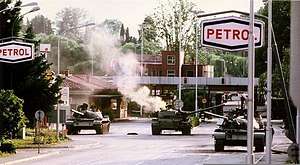
The initial revolutionary events in Slovenia pre-dated the Revolutions of 1989 in Eastern Europe by almost a year, but went largely unnoticed by international observers. On 23 December 1990, more than 88% of the electorate voted for a sovereign and independent Slovenia.[82][83] On 25 June 1991, Slovenia became independent[4] through the passage of appropriate legal documents.[84] On 27 June in the early morning, the Yugoslav People's Army dispatched its forces to prevent further measures for the establishment of a new country, which led to the Ten-Day War.[85][86] On 7 July, the Brijuni Agreement was signed, implementing a truce and a three-month halt of the enforcement of Slovenia's independence.[87] At the end of the month, the last soldiers of the Yugoslav Army left Slovenia.
In December 1991, a new constitution was adopted,[84] followed in 1992 by the laws on denationalisation and privatization.[88] The members of the European Union recognised Slovenia as an independent state on 15 January 1992, and the United Nations accepted it as a member on 22 May 1992.[89]
Slovenia joined the European Union on 1 May 2004. Slovenia has one Commissioner in the European Commission, and seven Slovene parliamentarians were elected to the European Parliament at elections on 13 June 2004. In 2004 Slovenia also joined NATO. Slovenia subsequently succeeded in meeting the Maastricht criteria and joined the Eurozone (the first transition country to do so) on 1 January 2007. It was the first post-Communist country to hold the Presidency of the Council of the European Union, for the first six months of 2008. On 21 July 2010, it became a member of the OECD.[90]
The disillusionment with domestic socio-economic elites at municipal and national levels was expressed at the 2012–2013 Slovenian protests on a wider scale than in the smaller 15 October 2011 protests.[91] In relation to the leading politicians' response to allegations made by the official Commission for the Prevention of Corruption of the Republic of Slovenia, legal experts expressed the need for changes in the system that would limit political arbitrariness.[92]
Geography


Slovenia is situated in Central and Southeastern Europe touching the Alps and bordering the Mediterranean. It lies between latitudes 45° and 47° N, and longitudes 13° and 17° E. The 15th meridian east almost corresponds to the middle line of the country in the direction west–east.[93] The Geometrical Center of the Republic of Slovenia is located at coordinates 46°07'11.8" N and 14°48'55.2" E.[94] It lies in Slivna in the Municipality of Litija.[95] Slovenia's highest peak is Triglav (2,864 m or 9,396 ft); the country's average height above sea level is 557 m (1,827 ft).
Four major European geographic regions meet in Slovenia: the Alps, the Dinarides, the Pannonian Plain, and the Mediterranean. Although on the shore of the Adriatic Sea near the Mediterranean Sea, most of Slovenia is in the Black Sea drainage basin. The Alps—including the Julian Alps, the Kamnik-Savinja Alps and the Karawank chain, as well as the Pohorje massif—dominate Northern Slovenia along its long border with Austria. Slovenia's Adriatic coastline stretches approximately 47 kilometres (29 mi)[96] from Italy to Croatia.
The term "Karst topography" refers to that of southwestern Slovenia's Karst Plateau, a limestone region of underground rivers, gorges, and caves, between Ljubljana and the Mediterranean sea. On the Pannonian plain to the East and Northeast, toward the Croatian and Hungarian borders, the landscape is essentially flat. However, the majority of Slovenian terrain is hilly or mountainous, with around 90% of the surface 200 m (656 ft) or more above sea level.
Over half of the country (11,823 km2 or 4,565 sq mi) is covered by forests.[97] This makes Slovenia the third most forested country in Europe, after Finland and Sweden. The areas are covered mostly by beech, fir-beech and beech-oak forests and have a relatively high production capacity.[98] Remnants of primeval forests are still to be found, the largest in the Kočevje area. Grassland covers 5,593 km2 (2,159 sq mi) and fields and gardens (954 km2 or 368 sq mi). There are 363 km2 (140 sq mi) of orchards and 216 km2 (83 sq mi) of vineyards.
Geology

Slovenia is in a rather active seismic zone because of its position on the small Adriatic Plate, which is squeezed between the Eurasian Plate to the north and the African Plate to the south and rotates counter-clockwise.[99] Thus the country is at the junction of three important geotectonic units: the Alps to the north, the Dinaric Alps to the south and the Pannonian Basin to the east.[99] Scientists have been able to identify 60 destructive earthquakes in the past. Additionally, a network of seismic stations is active throughout the country.[99] Many parts of Slovenia have a carbonate ground, and an extensive subterranean system has developed.
Natural regions
The first regionalisations of Slovenia were made by geographers Anton Melik (1935–1936) and Svetozar Ilešič (1968). The newer regionalisation by Ivan Gams divided Slovenia in the following macroregions:[100]
.jpg)
- the Alps (Alpe)
- the subalpine landscapes (predalpski svet)
- the Slovene Littoral or Submediterranean Slovenia (Primorje or submediteranska Slovenija)
- the Dinaric plateaus of the continental Slovenia (dinarske planote celinske Slovenije)
- Subpannonian Slovenia (subpanonska Slovenija)
According to a newer natural geographic regionalisation, the country consists of four macroregions. These are the Alpine, the Mediterranean, the Dinaric, and the Pannonian landscapes. Macroregions are defined according to major relief units (the Alps, the Pannonian plain, the Dinaric mountains) and climate types (submediterranean, temperate continental, mountain climate).[101] These are often quite interwoven.
Protected areas of Slovenia include national parks, regional parks, and nature parks, the largest of which is Triglav National Park. There are 286 Natura 2000 designated protected areas, which comprise 36% of the country's land area, the largest percentage among European Union states.[102] Additionally, according to Yale University's Environmental Performance Index, Slovenia is considered a "strong performer" in environmental protection efforts.[103]
Climate
.jpg)
Slovenia is located in temperate latitudes. The climate is also influenced by the variety of relief, and the influence of the Alps and the Adriatic Sea. In the northeast, the continental climate type with greatest difference between winter and summer temperatures prevails. In the coastal region, there is sub-Mediterranean climate. The effect of the sea on the temperature rates is visible also up the Soča valley, while a severe Alpine climate is present in the high mountain regions. There is a strong interaction between these three climatic systems across most of the country.[104][105]
Precipitation, often coming from Gulf of Genoa,[106] varies across the country as well, with over 3,500 mm (138 in) in some western regions and dropping down to 800 mm (31 in) in Prekmurje. Snow is quite frequent in winter and the record snow cover in Ljubljana was recorded in 1952 at 146 cm (57 in).
Compared to Western Europe, Slovenia is not very windy, because it lies in the slipstream of the Alps. The average wind speeds are lower than in the plains of the nearby countries. Due to the rugged terrain, local vertical winds with daily periods are present. Besides these, there are three winds of particular regional importance: the bora, the jugo, and the foehn. The jugo and the bora are characteristic of the Littoral. Whereas the jugo is humid and warm, the bora is usually cold and gusty. The foehn is typical of the Alpine regions in the north of Slovenia. Generally present in Slovenia are the northeast wind, the southeast wind and the north wind.[107]
Waters
.jpg)
The territory of Slovenia mainly (16,423 square kilometers or 6,341 square miles, i.e. 81%) belongs to the Black Sea basin, and a smaller part (3,850 square kilometers or 1,490 square miles, i.e. 19%) belongs to the Adriatic Sea basin. These two parts are divided into smaller units in regard to their central rivers, the Mura River basin, the Drava River basin, the Sava River basin with Kolpa River basin, and the basin of the Adriatic rivers.[108] In comparison with other developed countries, water quality in Slovenia is considered to be among the highest in Europe. One of the reasons is undoubtedly that most of the rivers rise on the mountainous territory of Slovenia. But this does not mean that Slovenia has no problems with surface water and groundwater quality, especially in areas with intensive farming.[109]
Biodiversity
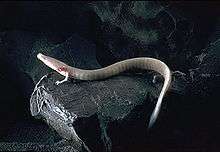
Slovenia signed the Rio Convention on Biological Diversity on 13 June 1992 and became a party to the convention on 9 July 1996.[110] It subsequently produced a National Biodiversity Strategy and Action Plan, which was received by the convention on 30 May 2002.
Slovenia is distinguished by an exceptionally wide variety of habitats,[111] due to the contact of geological units and biogeographical regions, and due to human influences. Around 12.5% of the territory is protected with 35.5% in the Natura 2000 ecological network.[112] Despite this, because of pollution and environmental degradation, diversity has been in decline.
Animals
The biological diversity of the country is high, with 1% of the world's organisms on 0.004% of the Earth's surface area.[113] There are 75 mammal species, among them marmots, Alpine ibex, and chamois. There are numerous deer, roe deer, boar, and hares.[114] The edible dormouse is often found in the Slovenian beech forests. Trapping these animals is a long tradition and is a part of the Slovenian national identity.[115]

Some important carnivores include the Eurasian lynx,[116][117] European wild cats, foxes (especially the red fox), and European jackal.[118] There are hedgehogs, martens, and snakes such as vipers and grass snakes. According to recent estimates, Slovenia has c. 40–60 wolves[119] and about 450 brown bears.[120][121]
Slovenia is home to an exceptionally diverse number of cave species, with a few tens of endemic species.[122] Among the cave vertebrates, the only known one is the olm, living in Karst, Lower Carniola, and White Carniola.
The only regular species of cetaceans found in the northern Adriatic sea is the bottlenose dolphin (Tursiops truncatus).[123]
There are a wide variety of birds, such as the tawny owl, the long-eared owl, the eagle owl, hawks, and short-toed eagles. Other birds of prey have been recorded, as well as a growing number of ravens, crows and magpies migrating into Ljubljana and Maribor where they thrive.[124] Other birds include black and green woodpeckers and the white stork, which nests mainly in Prekmurje.
.jpg)
There are 13 domestic animals native to Slovenia,[125] of eight species (hen, pig, dog, horse, sheep, goat, honey bee, and cattle).[126] Among these are the Karst Shepherd,[127] the Carniolan honeybee, and the Lipizzan horse.[126] They have been preserved ex situ and in situ.[128] The marble trout or marmorata (Salmo marmoratus) is an indigenous Slovenian fish.[129] Extensive breeding programmes have been introduced to repopulate the marble trout into lakes and streams invaded by non-indigenous species of trout. Slovenia is also home to the wels catfish.
Fungi
More than 2,400 fungal species have been recorded from Slovenia[130] and, since that figure does not include lichen-forming fungi, the total number of Slovenian fungi already known is undoubtedly much higher. Many more remain to be discovered.
Plants
Slovenia is the third most-forested country in Europe,[131] with 58.3% of the territory covered by forests.[132] The forests are an important natural resource, and logging is kept to a minimum. In the interior of the country are typical Central European forests, predominantly oak and beech. In the mountains, spruce, fir, and pine are more common. Pine trees grow on the Karst Plateau, although only one-third of the region is covered by pine forest. The lime/linden tree, common in Slovenian forests, is a national symbol. The tree line is at 1,700 to 1,800 metres (5,600 to 5,900 feet).[133]
In the Alps, flowers such as Daphne blagayana, gentians (Gentiana clusii, Gentiana froelichi), Primula auricula, edelweiss (the symbol of Slovene mountaineering), Cypripedium calceolus, Fritillaria meleagris (snake's head fritillary), and Pulsatilla grandis are found.
Slovenia harbors many plants of ethnobotanically useful groups. Of 59 known species of ethnobotanical importance, some species such as Aconitum napellus, Cannabis sativa and Taxus baccata are restricted for use as per the Official Gazette of the Republic of Slovenia.[134]
Politics
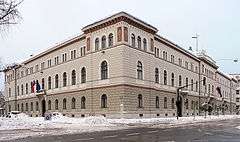
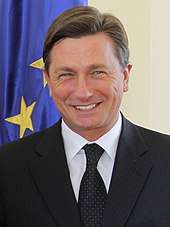
Slovenia is a parliamentary democracy republic with a multi-party system. The head of state is the president, who is elected by popular vote and has an important integrative role.[135] The president is elected for five years and at maximum for two consecutive terms. He or she mainly has a representative role and is the commander-in-chief of the Slovenian armed forces.[136]
The executive and administrative authority in Slovenia is held by the Government of Slovenia (Vlada Republike Slovenije),[89] headed by the Prime Minister and the council of ministers or cabinet, who are elected by the National Assembly (Državni zbor Republike Slovenije). The legislative authority is held by the bicameral Parliament of Slovenia, characterised by an asymmetric duality.[137] The bulk of power is concentrated in the National Assembly, which consists of ninety members. Of those, 88 are elected by all the citizens in a system of proportional representation, whereas two are elected by the registered members of the autochthonous Hungarian and Italian minorities. Election takes place every four years. The National Council (Državni svet Republike Slovenije), consisting of forty members, appointed to represent social, economic, professional and local interest groups, has a limited advisory and control power.[137] The 1992–2004 period was marked by the rule of the Liberal Democracy of Slovenia, which was responsible for gradual transition from the Titoist economy to the capitalist market economy. It later attracted much criticism by neo-liberal economists, who demanded a less gradual approach. The party's president Janez Drnovšek, who served as prime minister between 1992 and 2002, was one of the most influential Slovenian politicians of the 1990s,[138] alongside President Milan Kučan (who served between 1990 and 2002).[139][140]
The 2005–2008 period was characterized by over-enthusiasm after joining the EU. During the first term of Janez Janša's government, for the first time after independence, the Slovenian banks saw their loan-deposit ratios veering out of control. There was over-borrowing from foreign banks and then over-crediting of customers, including local business magnates.
After the onset of the financial crisis of 2007–2010 and European sovereign-debt crisis, the left-wing coalition that replaced Janša's government in the 2008 elections, had to face the consequences of the 2005–2008 over-borrowing. Attempts to implement reforms that would help economic recovery were met by student protesters, led by a student who later became a member of Janez Janša's SDS, and by the trade unions. The proposed reforms were postponed in a referendum. The left-wing government was ousted with a vote of no confidence. Janez Janša attributed the boom of spending and overborrowing to the period of left-wing government; he proposed harsh austerity reforms which he had previously helped postpone. Generally, some economists estimate that left and right parties attributed to over-loaning and managers' takeovers; reason behind was that each block tried to establish economic elite which will support political forces.[141]
Judiciary
Judicial powers in Slovenia are executed by judges, who are elected by the National Assembly. Judicial power in Slovenia is implemented by courts with general responsibilities and specialised courts that deal with matters relating to specific legal areas. The State Prosecutor is an independent state authority responsible for prosecuting cases brought against those suspected of committing criminal offences. The Constitutional Court, composed of nine judges elected for nine-year terms, decides on the conformity of laws with the Constitution; all laws and regulations must also conform with the general principles of international law and with ratified international agreements.[59]
Administrative divisions and traditional regions
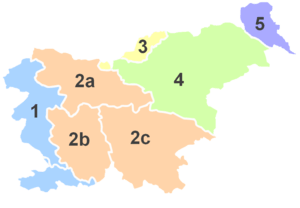 |
2a Upper, 2b Inner, 2c Lower 3 Carinthia; 4 Styria; 5 Prekmurje |
Municipalities
Officially, Slovenia is subdivided into 212 municipalities (eleven of which have the status of urban municipalities). The municipalities are the only bodies of local autonomy in Slovenia. Each municipality is headed by a mayor (župan), elected every four years by popular vote, and a municipal council (občinski svet). In the majority of municipalities, the municipal council is elected through the system of proportional representation; only a few smaller municipalities use the plurality voting system. In the urban municipalities, the municipal councils are called town (or city) councils.[142] Every municipality also has a Head of the Municipal Administration (načelnik občinske uprave), appointed by the mayor, who is responsible for the functioning of the local administration.[142]
_-_colored.svg.png)
Administrative districts
There is no official intermediate unit between the municipalities and the Republic of Slovenia. The 62 administrative districts, officially called "Administrative Units" (upravne enote), are only subdivisions of the national government administration and are named after their respective bases of government offices. They are headed by a Manager of the Unit (načelnik upravne enote), appointed by the Minister of Public Administration.
Traditional regions and identities
Traditional regions were based on the former Habsburg crown lands that included Carniola, Carinthia, Styria, and the Littoral. Stronger than with either the Carniola as a whole, or with Slovenia as the state, Slovenes historically tend to identify themselves with the traditional regions of Slovene Littoral, Prekmurje, and even traditional (sub)regions, such as Upper, Lower and, to a lesser extent, Inner Carniola.[143]
The capital city Ljubljana was historically the administrative center of Carniola and belonged to Inner Carniola,[144] except for the Šentvid district, which was in Upper Carniola and also where the border between German-annexed territory and the Italian Province of Ljubljana was during the Second World War.[144]
Statistical regions
The 12 statistical regions have no administrative function and are subdivided into two macroregions for the purpose of the Regional policy of the European Union.[145] These two macroregions are:
- Eastern Slovenia (Vzhodna Slovenija – SI01), which groups the Mura, Drava, Carinthia, Savinja, Central Sava, Lower Sava, Southeast Slovenia, and Inner Carniola–Karst statistical regions.
- Western Slovenia (Zahodna Slovenija – SI02), which groups the Central Slovenia, Upper Carniola, Gorizia, and Coastal–Karst statistical regions.
Military

.jpg)
The Slovenian Armed Forces provide military defence independently or within an alliance, in accordance with international agreements. Since conscription was abolished in 2003, it is organized as a fully professional standing army.[146] The Commander-in-Chief is the President of the Republic of Slovenia, while operational command is in the domain of the Chief of the General Staff of the Slovenian Armed Forces. In 2016, military spending was an estimated 0.91% of the country's GDP. Since joining NATO, the Slovenian Armed Forces have taken a more active part in supporting international peace. They have participated in peace support operations and humanitarian activities. Among others, Slovenian soldiers are a part of international forces serving in Bosnia and Herzegovina, Kosovo, and Afghanistan.[147]
Economy
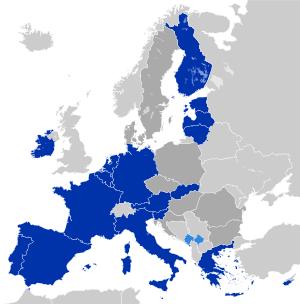
Slovenia has a developed economy and is per capita the richest of the Slavic countries by nominal GDP,[148] and the second richest by GDP (PPP) behind the Czech Republic.[149] Slovenia is also among the top global economies in terms of human capital.[150] Slovenia was in the beginning of 2007 the first new member to introduce the euro as its currency, replacing the tolar. Since 2010, it has been member of the Organisation for Economic Co-operation and Development.[38][151] There is a big difference in prosperity between the various regions. The economically wealthiest regions are the Central Slovenia region which includes the capital Ljubljana and the western Slovenian regions, as Goriška and Coastal–Karst, while the least wealthy regions are the Mura, the Central Sava and the Littoral–Inner Carniola.[152]
Economic growth
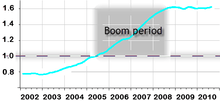
In 2004–06, the economy grew on average by nearly 5% a year in Slovenia; in 2007, it expanded by almost 7%. The growth surge was fuelled by debt, particularly among firms, and especially in construction. The financial crisis of 2007–2010 and European sovereign-debt crisis had a significant impact on the domestic economy.[154] The construction industry was severely hit in 2010 and 2011.[155]
In 2009, Slovenian GDP per capita shrank by 8%, the biggest decline in the European Union after the Baltic countries and Finland. An increasing burden for the Slovenian economy has been its rapidly ageing population.[156]
In August 2012, the year-on-year contraction was 0.8%, however, 0.2% growth was recorded in the first quarter (in relation to the quarter before, after data was adjusted according to season and working days).[157] Year-on-year contraction has been attributed to the fall in domestic consumption, and the slowdown in export growth. The decrease in domestic consumption has been attributed to the fiscal austerity, to the freeze on budget expenditure in the final months of 2011,[158] to the failure of the efforts to implement economic reforms, to inappropriate financing, and to the decrease in exports.[159]
Due to the effects of the crisis it was expected that several banks had to be bailed out by EU funds in 2013, however needed capital was able to be covered by the country's own funds. Fiscal actions and legislations aiming on the reduction of spendings as well as several privatisations supported an economic recovery as from 2014.[160] The real economic growth rate was at 2.5% in 2016 and accelerated to 5% in 2017.[161] The construction sector has seen a recent increase,[161] and the tourism industry is expected to have continuous rising numbers.[162]
National debt
Slovenia's total national debt rose substantially during the Great Recession and was decreasing as of 2019; at the end of 2018 amounted to 32,223 million euros, 70% of the GDP.[163]
Services and industry
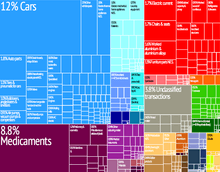
Almost two-thirds of people are employed in services, and over one-third in industry and construction.[164] Slovenia benefits from a well-educated workforce, well-developed infrastructure, and its location at the crossroads of major trade routes.[38]
The level of foreign direct investment (FDI) per capita in Slovenia is one of the lowest in the EU,[38] and the labor productivity and the competitiveness of the Slovenian economy is still significantly below the EU average.[165][166] Taxes are relatively high, the labor market is seen by business interests as being inflexible, and industries are losing sales to China, India, and elsewhere.[167]
High level of openness makes Slovenia extremely sensitive to economic conditions in its main trading partners and changes in its international price competitiveness.[168] The main industries are motor vehicles, electric and electronic equipment, machinery, pharmaceuticals, and fuels.[38] Examples of major Slovenian companies operating in Slovenia include the home appliance manufacturer Gorenje, the pharmaceutical companies Krka and Lek (Novartis' subsidiary), the oil distributing company Petrol Group, energy distribution company GEN-I and Revoz, a manufacturing subsidiary of Renault.[169][170][171]
Energy
In 2018, the net energy production was 12,262 GWh and consumption was 14,501 GWh. Hydroelectric plants produced 4,421 GWh, thermal plants produced 4,049 GWh, and the Krško Nuclear Power Plant produced 2,742 GWh (50% share that goes to Slovenia; other 50% goes to Croatia due to joint ownership). Domestic electricity consumption was covered 84.6% by domestic production; percentage is decreasing from year to year meaning Slovenia is more and more depending on electricity import.[172]
A new 600 MW block of Šoštanj thermal power plant finished construction and went online in the autumn of 2014.[173] The new 39.5 MW HE Krško hydro power plant was finished in 2013, and has since been the largest sole energy producer, accounting for of the gross energy production in 2018.[174] The 41.5 MW HE Brežice and 30.5 MW HE Mokrice hydro power plants were built on the Sava River in 2018 and the construction of ten more hydropower plants with a cumulative capacity of 338 MW is planned to be finished by 2030. A large pumped-storage hydro power plant Kozjak on the Drava River is in the planning stage.
At the end of 2018, at least 295 MWp of photovoltaic modules and 31,4 MW of biogas powerplants were installed. Compared to 2017, renewable energy sources contributed 5,6 percentage points more into whole energy consumption. There is interest to add more production in the area of solar and wind energy sources (subsidising schemes are increasing economic feasibility), but microlocation settlement procedures take enormous toll on the efficiency of this intitiatve (nature preservation vs. energy production facilities dilemma).[172]
Tourism
Slovenia offers tourists a wide variety of natural and cultural amenities. Different forms of tourism have developed. The tourist gravitational area is considerably large, however the tourist market is small. There has been no large-scale tourism and no acute environmental pressures;[175] in 2017, National Geographic Traveller's Magazine declared Slovenia as the country with the world's most sustainable tourism.[176]
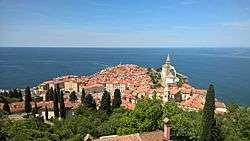
The nation's capital, Ljubljana, has many important Baroque and Vienna Secession buildings, with several important works of the native born architect Jože Plečnik[177] and also his pupil, architect Edo Ravnikar.
At the northwestern corner of the country lie the Julian Alps with Lake Bled and the Soča Valley, as well as the nation's highest peak, Mount Triglav in the middle of Triglav National Park. Other mountain ranges include Kamnik–Savinja Alps, the Karawanks, and Pohorje, popular with skiers and hikers.[178]
The Karst Plateau in the Slovene Littoral gave its name to karst, a landscape shaped by water dissolving the carbonate bedrock, forming caves. The best-known caves are Postojna Cave and the UNESCO-listed Škocjan Caves. The region of Slovenian Istria meets the Adriatic Sea, where the most important historical monument is the Venetian Gothic Mediterranean town of Piran while the settlement of Portorož attracts crowds in summer.[179]
The hills around Slovenia's second-largest town, Maribor, are renowned for their wine-making. The northeastern part of the country is rich with spas,[180] with Rogaška Slatina, Radenci, Čatež ob Savi, Dobrna, and Moravske Toplice growing in importance in the last two decades.[181]
Other popular tourist destinations include the historic cities of Ptuj and Škofja Loka, and several castles, such as Predjama Castle.[182][183]
Important parts of tourism in Slovenia include congress and gambling tourism. Slovenia is the country with the highest percentage of casinos per 1,000 inhabitants in the European Union.[184] Perla in Nova Gorica is the largest casino in the region.[185]
Most of foreign tourists to Slovenia come from the key European markets: Italy, Austria, Germany, Croatia, Benelux, Serbia, Russia and Ukraine, followed by UK and Ireland.[186] European tourists create more than 90% of Slovenia's tourist income. In 2016, Slovenia was declared the world's first green country by the Netherlands-based organization Green Destinations.[187] On being declared the most sustainable country in 2016, Slovenia had a big part to play at the ITB Berlin to promote sustainable tourism.
Transport
Since Antiquity, geography has dictated transport routes in Slovenia. Significant mountain ranges, major rivers and proximity to the Danube played roles in the development of the area's transportation corridors. One recent particular advantage are the Pan-European transport corridors V (the fastest link between the North Adriatic, and Central and Eastern Europe) and X (linking Central Europe with the Balkans). This gives it a special position in the European social, economic and cultural integration and restructuring.[188]
Roads
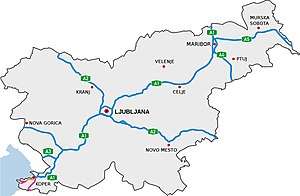
The road freight and passenger transport constitutes the largest part of transport in Slovenia at 80%.[189] Personal cars are much more popular than public road passenger transport, which has significantly declined.[189][190] Slovenia has a very high highway and motorway density compared to the European Union average.[191] The highway system, the construction of which was accelerated after 1994,[192] has slowly but steadily transformed Slovenia into a large conurbation.[193] Other state roads have been rapidly deteriorating because of neglect and the overall increase in traffic.[191]
Railways
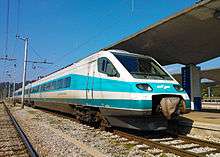
The existing Slovenian railways are out-of-date and can't compete with the motorway network; partially also as a result of dispersed population settlement.[194] Due to this fact and the projected increase in traffic through the port of Koper, which is primarily by train, a second rail on the Koper-Divača route is in early stages of starting construction.[195] With a lack of financial assets, maintenance and modernisation of the Slovenian railway network have been neglected.[196] Due to the out-of-date infrastructure, the share of the railway freight transport has been in decline in Slovenia.[197] The railway passenger transport has been recovering after a large drop in the 1990s.[197] The Pan-European railway corridors V and X, and several other major European rail lines intersect in Slovenia.[196] All international transit trains in Slovenia drive through the Ljubljana Railway Hub.[198]
Ports
The major Slovenian port is the Port of Koper. It is the largest Northern Adriatic port in terms of container transport,[199] with almost 590,000 TEUs annually[200] and lines to all major world ports.[201][202] It is much closer to destinations east of the Suez than the ports of Northern Europe.[201] In addition, the maritime passenger traffic mostly takes place in Koper.[203] Two smaller ports used for the international passenger transport as well as cargo transport are located in Izola and Piran. Passenger transport mainly takes place with Italy and Croatia.[204] Splošna plovba,[205] the only Slovenian shipping company, transports freight and is active only in foreign ports.[203]
Air
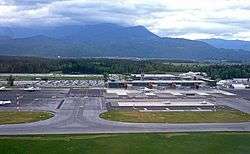
Air transport in Slovenia is quite low,[197] but has significantly grown since 1991.[206] Of the three international airports in Slovenia, Ljubljana Jože Pučnik Airport in central Slovenia is the busiest,[206] with connections to many major European destinations.[207] The Maribor Edvard Rusjan Airport is located in the eastern part of the country and the Portorož Airport in the western part.[206] The state-owned Adria Airways is the largest Slovenian airline; however in 2019 it declared bankruptcy and ceased operations.[206] Since 2003, several new carriers have entered the market, mainly low-cost airlines.[191] The only Slovenian military airport is the Cerklje ob Krki Air Base in the southwestern part of the country.[208] There are also 12 public airports in Slovenia.[206]
Demographics
| Year | Pop. | ±% |
|---|---|---|
| 1921 | 1,054,919 | — |
| 1931 | 1,144,298 | +8.5% |
| 1948 | 1,391,873 | +21.6% |
| 1953 | 1,466,425 | +5.4% |
| 1961 | 1,591,523 | +8.5% |
| 1971 | 1,727,137 | +8.5% |
| 1981 | 1,891,864 | +9.5% |
| 1991 | 1,913,355 | +1.1% |
| 2002 | 1,964,036 | +2.6% |
| 2011 | 2,050,189 | +4.4% |
| 2017 | 2,065,895 | +0.8% |
| As of 1 January | ||

With 101 inhabitants per square kilometer (262/sq mi), Slovenia ranks low among the European countries in population density (compared to 402/km2 (1042/sq mi) for the Netherlands or 195/km2 (505/sq mi) for Italy). The Inner Carniola–Karst Statistical Region has the lowest population density while the Central Slovenia Statistical Region has the highest.[209]
Slovenia is among the European countries with the most pronounced ageing of its population, ascribable to a low birth rate and increasing life expectancy.[210] Almost all Slovenian inhabitants older than 64 are retired, with no significant difference between the genders.[211] The working-age group is diminishing in spite of immigration.[212] The proposal to raise the retirement age from the current 57 for women and 58 for men was rejected in a referendum in 2011.[156] In addition, the difference among the genders regarding life expectancy is still significant.[211] The total fertility rate (TFR) in 2014 was estimated at 1.33 children born/woman, which is lower than the replacement rate of 2.1.[213] The majority of children are born to unmarried women (in 2016, 58.6% of all births were outside of marriage).[214] In 2018, life expectancy at birth was 81.1 years (78.2 years male, and 84 years female).[215]
In 2009, the suicide rate in Slovenia was 22 per 100,000 persons per year, which places Slovenia among the highest ranked European countries in this regard.[216] Nonetheless, from 2000 until 2010, the rate has decreased by about 30%. The differences between regions and the genders are pronounced.[217]
Urbanisation
Depending on definition, between 65% and 79% of people live in wider urban areas.[218] According to OECD definition of rural areas none of the Slovene statistical regions is mostly urbanised, meaning that 15% or less of the population lives in rural communities. According to this definition statistical regions are classified:
- mostly rural regions: Mura, Drava, Carinthia, Savinja, Lower Sava, Littoral–Inner Carniola, Gorizia, Southeast Slovenia
- moderately rural regions: Central Sava, Upper Carniola, Coastal–Karst, Central Slovenia.[219]
The only large town is the capital, Ljubljana. Other (medium-sized) towns include Maribor, Celje, and Kranj.[220][221] Overall, there are eleven urban municipalities in Slovenia.
Municipalities by population
212 municipalities in total. Hodoš, the smallest, has 354 inhabitants. |
Municipalities by area
Odranci, the smallest, measures 6.9 km2. |
Languages
The official language in Slovenia is Slovene, which is a member of the South Slavic language group. In 2002, Slovene was the native language of around 88% of Slovenia's population according to the census, with more than 92% of the Slovenian population speaking it in their home environment.[222][223] This statistic ranks Slovenia among the most homogeneous countries in the EU in terms of the share of speakers of the predominant mother tongue.[224]
Slovene is a highly diverse Slavic language in terms of dialects,[225] with different degrees of mutual intelligibility. Accounts of the number of dialects range from as few as seven[226][227][228] dialects, often considered dialect groups or dialect bases that are further subdivided into as many as 50 dialects.[229] Other sources characterize the number of dialects as nine[230] or as eight.[231]
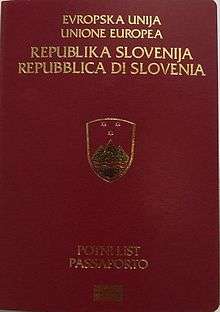
Hungarian and Italian, spoken by the respective minorities, enjoy the status of official languages in the ethnically mixed regions along the Hungarian and Italian borders, to the extent that even the passports issued in those areas are bilingual. In 2002 around 0.2% of the Slovenian population spoke Italian and around 0.4% spoke Hungarian as their native language. Hungarian is co-official with Slovene in 30 settlements in 5 municipalities (whereof 3 are officially bilingual). Italian is co-official with Slovene in 25 settlements in 4 municipalities (all of them officially bilingual).
Romani,[232] spoken in 2002 as the native language by 0.2% of people, is a legally protected language in Slovenia. Romani-speakers mainly belong to the geographically dispersed and marginalized Roma community.[233]
German, which used to be the largest minority language in Slovenia prior to World War II (around 4% of the population in 1921), is now the native language of only around 0.08% of the population, the majority of whom are more than 60 years old.[223] Gottscheerish or Granish, the traditional German dialect of Gottschee County, faces extinction.[234]
A significant number of people in Slovenia speak a variant of Serbo-Croatian (Serbian, Croatian, Bosnian, or Montenegrin) as their native language. These are mostly immigrants who moved to Slovenia from other former Yugoslav republics from the 1960s to the late 1980s, and their descendants. In 2002, 0.4% of the Slovenian population declared themselves to be native speakers of Albanian and 0.2% native speakers of Macedonian.[223] Czech, the fourth-largest minority language in Slovenia prior to World War II (after German, Hungarian, and Serbo-Croatian), is now the native language of a few hundred residents of Slovenia.[223]
Regarding the knowledge of foreign languages, Slovenia ranks among the top European countries. The most taught foreign languages are English, German, Italian, French and Spanish. As of 2007, 92% of the population between the age of 25 and 64 spoke at least one foreign language and around 71.8% of them spoke at least two foreign languages, which was the highest percentage in the European Union.[235] According to the Eurobarometer survey, as of 2005 the majority of Slovenes could speak Croatian (61%) and English (56%).[236]:21
A reported 42% of Slovenes could speak German, which was one of the highest percentages outside German-speaking countries.[236] Italian is widely spoken on the Slovenian Coast and in some other areas of the Slovene Littoral. Around 15% of Slovenians can speak Italian, which is (according to the Eurobarometer pool) the third-highest percentage in the European Union, after Italy and Malta.[237]
Immigration
In 2015 about 12% (237,616 people) of the population in Slovenia was born abroad.[238] About 86% of the foreign-born population originated from other countries of the former Yugoslavia state as (in descending order) Bosnia-Herzegovina, followed by immigrants from Croatia, Serbia, North Macedonia and Kosovo.[238]
By the beginning of 2017 there were about 114,438 people with a foreign citizenship residing in the country making up 5.5% of the total population. Of these foreigners 76% had citizenships of the other countries from the former Yugoslavia state (excluding Croatia). Additionally 16.4% had EU-citizenships and 7.6% had citizenships of other countries.[238]
According to the 2002 census, Slovenia's main ethnic group are Slovenes (83%), however their share in the total population is continuously decreasing due to their relatively low fertility rate. At least 13% (2002) of the population were immigrants from other parts of Former Yugoslavia and their descendants.[239] They have settled mainly in cities and suburbanised areas.[240] Relatively small but protected by the Constitution of Slovenia are the Hungarian and the Italian ethnic minority.[241][242][243] A special position is held by the autochthonous and geographically dispersed Roma ethnic community.[244][245]
The number of people immigrating into Slovenia rose steadily from 1995[246] and has been increasing even more rapidly in recent years. After Slovenia joined the EU in 2004, the annual number of immigrants doubled by 2006 and increased by half yet again by 2009.[247] In 2007, Slovenia had one of the fastest growing net migration rates in the European Union.[246]
Emigration
As to emigration, between 1880 and 1918 (World War I) many men left Slovenia to work in mining areas in other nations. The United States in particular has been a common choice for emigration, with the 1910 US Census showing that there were already "183,431 persons in the USA of Slovenian mother tongue". But there may have been many more, because a good number avoided anti-Slavic prejudice and "identified themselves as Austrians." Favorite localities before 1900 were Minnesota, Wisconsin, Michigan, as well as Omaha, Nebraska, Joliet, Illinois, Cleveland, Ohio, and rural areas of Iowa. After 1910, they settled in Utah (Bingham Copper Mine), Colorado (especially Pueblo), and Butte, Montana. These areas attracted first many single men (who often boarded with Slovenian families). Then after locating work and having sufficient money, the men sent back for their wives and families to join them.[248]
Religion
Religion in Slovenia (December 2018)[3]
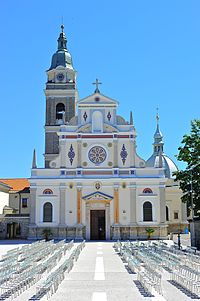
Before World War II, 97% of the population declared itself Catholic (Roman Rite), around 2.5% as Lutheran, and around 0.5% of residents identified themselves as members of other denominations.[223]
Catholicism was an important feature of both social and political life in pre-Communist Slovenia. After 1945, the country underwent a process of gradual but steady secularization. After a decade of persecution of religions, the Communist regime adopted a policy of relative tolerance towards churches. After 1990, the Catholic Church regained some of its former influence, but Slovenia remains a largely secularized society. According to the 2002 census, 57.8% of the population is Catholic. In 1991, 71.6% were self-declared Catholics which means a drop of more than 1% annually.[249] The vast majority of Slovenian Catholics belong to the Latin Rite. A small number of Greek Catholics live in the White Carniola region.[250]
Newest 2018 data shows a resurgence in people identifying as Catholics, membership in the Church has returned to pre 1990 levels. With 73.4% now again identifying as Catholic.[251]
Despite a relatively small number of Protestants (less than 1% in 2002), the Protestant legacy is historically significant given that the Slovene standard language and Slovene literature were established by the Protestant Reformation in the 16th century. Primoz Trubar, a theologian in the Lutheran tradition, was one of the most influential Protestant Reformers in Slovenia. Protestantism was extinguished in the Counter-Reformation implemented by the Habsburg dynasty, which controlled the region. It only survived in the easternmost regions due to protection of Hungarian nobles, who often happened to be Calvinist themselves. Today, a significant Lutheran minority lives in the easternmost region of Prekmurje, where they represent around a fifth of the population and are headed by a bishop with the seat in Murska Sobota.[252]
The third largest denomination, with around 2.2% of the population, is the Eastern Orthodox Church, with most adherents belonging to the Serbian Orthodox Church while a minority belongs to the Macedonian and other Eastern Orthodox churches.
According to the 2002 census, Islam is the second largest religious denomination in the country, with around 2.4% of the population. Most Slovenian Muslims came from Bosnia.[253]
Slovenia has long been home to a Jewish community. Despite the losses suffered during the Holocaust, Judaism still numbers a few hundred adherents, mostly living in Ljubljana, site of the sole remaining active synagogue in the country.[254]
In the 2002, around 10% of Slovenes declared themselves as atheists, another 10% professed no specific denomination, and around 16% decided not to answer the question about their religious affiliation. According to the Eurobarometer Poll 2010,[255] 32% of Slovenian citizens responded that "they believe there is a god", whereas 36% answered that "they believe there is some sort of spirit or life force" and 26% that "they do not believe there is any sort of spirit, god, or life force".[255]
Education
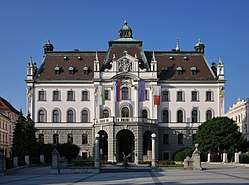
Slovenia's education ranks as the 12th best in the world and 4th best in the European Union, being significantly higher than the OECD average, according to the Programme for International Student Assessment.[256] Among people age 25 to 64, 12% have attended higher education, while on average Slovenes have 9.6 years of formal education. According to an OECD report, 83% of adults ages 25–64 have earned the equivalent of a high school degree, well above the OECD average of 74%; among 25- to 34-year-olds, the rate is 93%.[257] According to the 1991 census there is 99.6% literacy in Slovenia. Lifelong learning is also increasing.[258]
Primary
Responsibility for education oversight at primary and secondary level in Slovenia lies with the Ministry of Education and Sports. After non-compulsory pre-school education, children enter the nine-year primary school at the age of six.[259] Primary school is divided into three periods, each of three years. In the academic year 2006–2007 there were 166,000 pupils enrolled in elementary education and more than 13,225 teachers, giving a ratio of one teacher per 12 pupils and 20 pupils per class.[258]
Secondary
After completing elementary school, nearly all children (more than 98%) go on to secondary education, either vocational, technical or general secondary programmes (gimnazija). The latter concludes with matura, the final exam that allows the graduates to enter a university. 84% of secondary school graduates go on to tertiary education.[258]
Tertiary
Among several universities in Slovenia, the best ranked is the University of Ljubljana, ranking among the first 500 or the first 3% of the world's best universities according to the ARWU.[260][261] Two other public universities include the University of Maribor[262] in Styria region and the University of Primorska in Slovene Littoral.[263] In addition, there is a private University of Nova Gorica[264] and an international EMUNI University.[265]
Culture
Heritage
Slovenia's architectural heritage includes 2,500 churches, 1,000 castles, ruins, and manor houses, farmhouses, and special structures for drying hay, called hayracks (kozolci).[269]
Four natural and cultural sites in Slovenia are on the UNESCO World Heritage Site list. Škocjan Caves and its karst landscape are a protected site[270] as the old forests in the area of Goteniški Snežnik and Kočevski Rog in the SE Slovenia. The Idrija Mercury mining site is of world importance, as are the prehistoric pile dwellings in the Ljubljana Marshes.[271]
The most picturesque church for photographers is the medieval and Baroque building on Bled Island. The castle above the lake is a museum and restaurant with a view. Near Postojna there is a fortress called Predjama Castle, half hidden in a cave. Museums in Ljubljana and elsewhere feature unique items such as the Divje Babe Flute and the oldest wheel in the world. Ljubljana has medieval, Baroque, Art Nouveau, and modern architecture. The architect Plečnik's architecture and his innovative paths and bridges along the Ljubljanica are notable and on UNESCO tentative list.
Cuisine
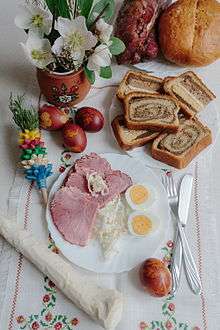
Slovenian cuisine is a mixture of Central European cuisine (especially Austrian and Hungarian), Mediterranean cuisine and Balkan cuisine. Historically, Slovenian cuisine was divided into town, farmhouse, cottage, castle, parsonage and monastic cuisines. Due to the variety of Slovenian cultural and natural landscapes, there are more than 40 distinct regional cuisines.
Ethnologically, the most characteristic Slovene dishes were one-pot dishes, such as ričet, Istrian stew (jota), minestrone (mineštra), and žganci buckwheat spoonbread; in the Prekmurje region there is also bujta repa, and prekmurska gibanica pastry. Pršut prosciutto is known as (pršut) in the Slovene Littoral. The nut roll (potica) has become a symbol of Slovenia, especially among the Slovene diaspora in the United States. Soups were added to the traditional one-pot meals and various kinds of porridge and stew only in relatively recent history.
Each year since 2000, the Festival of Roasted Potatoes has been organized by the Society for the Recognition of Roasted Potatoes as a Distinct Dish, attracting thousands of visitors. Roasted potatoes, which have been traditionally served in most Slovenian families only on Sundays—preceded by a meat-based soup, such as beef or chicken soup—have been depicted on a special edition of post marks by the Post of Slovenia on 23 November 2012.[272] The best known sausage is kranjska klobasa.
Dance
Ballet
Historically the most notable Slovenian ballet dancers and choreographers were Pino Mlakar (1907‒2006),[273] who in 1927 graduated from the Rudolf Laban Choreographic Institute, and there met his future wife, balerina Maria Luiza Pia Beatrice Scholz (1908‒2000). Together they worked as a leading dancer and a choreographer in Dessau (1930–1932), Zürich (1934–1938), and State opera in München (1939‒1944).[274] Their plan to build a Slovenian dance centre at Rožnik Hill after the World War II was supported by then minister of culture, Ferdo Kozak, but was cancelled by his successor.[275] Pino Mlakar was also a full professor at the Academy for Theatre, Radio, Film and Television (AGRFT) of the University of Ljubljana. Between 1952 in 1954 they again led State opera ballet in Munich.[274]
Modern dance
In the 1930s in Ljubljana was founded a Mary Wigman modern dance school by her student Meta Vidmar.[276]
Festivals, book fairs, and other events
A number of music, theater, film, book, and children's festivals take place in Slovenia each year, including the music festivals Ljubljana Summer Festival and Lent Festival, the stand up comedy Punch Festival, the children's Pippi Longstocking Festival, and the book festivals Slovene book fair and Frankfurt after the Frankfurt.
The most notable music festival of Slovene music was historically the Slovenska popevka festival. Between 1981 and 2000 the Novi Rock festival was notable for bringing rock music across Iron curtain from the West to the Slovenian and then Yugoslav audience. The long tradition of jazz festivals in Titoist Yugoslavia began with the Ljubljana Jazz Festival which has been held annually in Slovenia since 1960.[277]
Film
Film actors
Slovene film actors and actresses historically include Ida Kravanja, who played her roles as Ita Rina in the early European films, and Metka Bučar.[278] After the WW II, one of the most notable film actors was Polde Bibič, who played a number of roles in many films that were well received in Slovenia, including Don't Cry, Peter (1964), On Wings of Paper (1968), Kekec's Tricks (1968), Flowers in Autumn (1973), The Widowhood of Karolina Žašler (1976), Heritage (1986), Primož Trubar (1985), and My Dad, The Socialist Kulak (1987). Many of these were directed by Matjaž Klopčič. He also performed in television and radio drama.[279] Altogether, Bibič played over 150 theatre and over 30 film roles.[279]
Film directors
Feature film and short film production in Slovenia historically includes Karol Grossmann, František Čap, France Štiglic, Igor Pretnar, Jože Pogačnik, Peter Zobec, Matjaž Klopčič, Boštjan Hladnik, Dušan Jovanović, Vitan Mal, Franci Slak, and Karpo Godina as its most established filmmakers. Contemporary film directors Filip Robar - Dorin, Jan Cvitkovič, Damjan Kozole, Janez Lapajne, Mitja Okorn, and Marko Naberšnik are among the representatives of the so-called "Renaissance of Slovenian cinema". Slovene screenwriters, who are not film directors, include Saša Vuga and Miha Mazzini. Women film directors include Polona Sepe, Hanna A. W. Slak, and Maja Weiss.[280]
Literature
Authors
Today, notable authors include Slavoj Žižek, as well as Boris Pahor, a German Nazi concentration camp survivor, who opposed Italian Fascism and Titoist Communism.[281][282]
Literary history
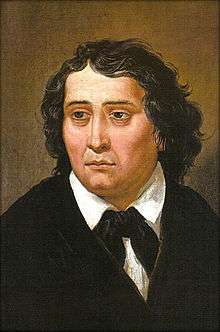
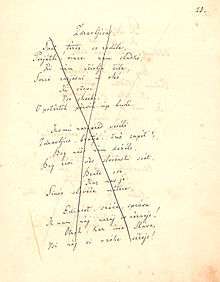
History of Slovene literature began in the 16th century with Primož Trubar and other Protestant Reformers. Poetry in the Slovene language achieved its highest level with the Romantic poet France Prešeren (1800–1849). In the 20th century, the Slovene literary fiction went through several periods: the beginning of the century was marked by the authors of the Slovene Modernism, with the most influential Slovene writer and playwright, Ivan Cankar; it was then followed by expressionism (Srečko Kosovel), avantgardism (Anton Podbevšek, Ferdo Delak) and social realism (Ciril Kosmač, Prežihov Voranc) before World War II, the poetry of resistance and revolution (Karel Destovnik Kajuh, Matej Bor) during the war, and intimism (Poems of the Four, 1953), post-war modernism (Edvard Kocbek), and existentialism (Dane Zajc) after the war.
Postmodernist authors include Boris A. Novak, Marko Kravos, Drago Jančar, Evald Flisar, Tomaž Šalamun, and Brina Svit. Among the post-1990 authors best known are Aleš Debeljak, Miha Mazzini, and Alojz Ihan. There are several literary magazines that publish Slovene prose, poetry, essays, and local literary criticism.
Music
The Slovenian Philharmonics, established in 1701 as part of Academia operosorum Labacensis, is among the oldest such institutions in Europe. Music of Slovenia historically includes numerous musicians and composers, such as the Renaissance composer Jacobus Gallus (1550–1591), who greatly influenced Central European classical music, the Baroque composer Janez Krstnik Dolar (ca. 1620–1673), and the violin virtuoso Giuseppe Tartini.
During the medieval era, secular music was as popular as church music, including wandering minnesingers. By the time of Protestant Reformation in the 16th century, music was used to proselytize. The first Slovenian hymnal, Eni Psalmi, was published in 1567. This period saw the rise of musicians like Jacobus Gallus and Jurij Slatkonja.[283]
In 1701, Johann Berthold von Höffer (1667–1718), a nobleman and amateur composer from Ljubljana, founded the Academia Philharmonicorum Labacensis, as one of the oldest such institutions in Europe, based on Italian models.[284]
Composers of Slovenian Lieder and art songs include Emil Adamič (1877–1936), Fran Gerbič (1840–1917), Alojz Geržinič (1915–2008), Benjamin Ipavec (1829–1908), Davorin Jenko (1835–1914), Anton Lajovic (1878–1960), Kamilo Mašek (1831–1859), Josip Pavčič (1870–1949), Zorko Prelovec (1887–1939), and Lucijan Marija Škerjanc (1900–1973).
In the early 20th century, impressionism was spreading across Slovenia, which soon produced composers Marij Kogoj and Slavko Osterc. Avant-garde classical music arose in Slovenia in the 1960s, largely due to the work of Uroš Krek, Dane Škerl, Primož Ramovš and Ivo Petrić, who also conducted the Slavko Osterc Ensemble. Jakob Jež, Darijan Božič, Lojze Lebič and Vinko Globokar have since composed enduring works, especially Globokar's L'Armonia, an opera.
Modern composers include Uroš Rojko, Tomaž Svete, Brina Jež-Brezavšček, Božidar Kantušer and Aldo Kumar. Kumar's Sonata z igro 12 (A sonata with a play 12), a set of variations on a rising chromatic scale, is particularly notable.
The Slovene National Opera and Ballet Theatre serves as the national opera and ballet house.
Traditional folk music
Harmony singing is a deep rooted tradition in Slovenia, and is at least three-part singing (four voices), while in some regions even up to eight-part singing (nine voices). Slovenian folk songs, thus, usually resounds soft and harmonious, and are very seldom in minor. Traditional Slovenian folk music is performed on Styrian harmonica (the oldest type of accordion), fiddle, clarinet, zithers, flute, and by brass bands of alpine type. In eastern Slovenia, fiddle and cimbalon bands are called velike goslarije.
Modern folk (Slovenian country) music

From 1952 on, the Slavko Avsenik's band began to appear in broadcasts, movies, and concerts all over the West Germany, inventing the original "Oberkrainer" country sound that has become the primary vehicle of ethnic musical expression not only in Slovenia, but also in Germany, Austria, Switzerland, and in the Benelux, spawning hundreds of Alpine orchestras in the process. The band produced nearly 1000 original compositions, an integral part of the Slovenian-style polka legacy. Many musicians followed Avsenik's steps, including Lojze Slak.[285]
Slovenska popevka
A similarly high standing in Slovene culture, like the Sanremo Music Festival has had in Italian culture, was attributed to the Slovenska popevka, a specific genre of popular Slovene music.[286]
Popular music
Among pop, rock, industrial, and indie musicians the most popular in Slovenia include Laibach, an early 1980s industrial music group as well as Siddharta, an alternative rock band formed in 1995.
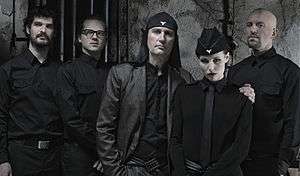
.jpg)
With more than 15 million views for the official a cappella "Africa" performance video since its publishing on YouTube in May 2009 until September 2013[287] that earned them kudos from the song's co-writer, David Paich,[288] Perpetuum Jazzile is the group from Slovenia that is internationally most listened online. Other Slovenian bands include a historically progressive rock ones that were also popular in Titoist Yugoslavia, such as Buldožer and Lačni Franz, which inspired later comedy rock bands including Zmelkoow, Slon in Sadež and Mi2.[289] With exception of Terrafolk that made appearances worldwide, other bands, such as Avtomobili, Zaklonišče Prepeva, Šank Rock, Big Foot Mama, Dan D, and Zablujena generacija, are mostly unknown outside the country. Slovenian metal bands include Noctiferia (death metal), Negligence (thrash metal), Naio Ssaion (gothic metal), and Within Destruction (deathcore).[290]
Singer-songwriters
Slovenian post-WWII singer-songwriters include Frane Milčinski (1914–1988), Tomaž Pengov whose 1973 album Odpotovanja is considered to be the first singer-songwriter album in former Yugoslavia,[291] Tomaž Domicelj, Marko Brecelj, Andrej Šifrer, Eva Sršen, Neca Falk, and Jani Kovačič. After 1990, Adi Smolar, Iztok Mlakar, Vita Mavrič, Vlado Kreslin, Zoran Predin, Peter Lovšin, and Magnifico have been popular in Slovenia, as well. In the 21st century, there have been many successful artsists from Slovenia. They include country musician Manu, Eurovision finalists zalagasper, Nika Zorjan, Omar Naber and Raiven.
Theatre

In addition to the main houses, which include Slovene National Theatre, Ljubljana and Maribor National Drama Theatre, a number of small producers are active in Slovenia, including physical theatre (e.g. Betontanc), street theatre (e.g. Ana Monró Theatre), theatresports championship Impro League, and improvisational theatre (e.g. IGLU Theatre). A popular form is puppetry, mainly performed in the Ljubljana Puppet Theatre. Theater has a rich tradition in Slovenia, starting with the 1867 first ever Slovene-language drama performance.
Visual arts, architecture and design
Slovenia's visual arts, architecture, and design are shaped by a number of architects, designers, painters, sculptors, photographers, graphics artists, as well as comics, illustration and conceptual artists. The most prestigious institutions exhibiting works of Slovene visual artists are the National Gallery of Slovenia and the Museum of Modern Art.
- Architecture
Modern architecture in Slovenia was introduced by Max Fabiani, and in the mid-war period, Jože Plečnik and Ivan Vurnik.[292] In the second half of the 20th century, the national and universal style were merged by the architects Edvard Ravnikar and first generation of his students: Milan Mihelič, Stanko Kristl, Savin Sever. Next generation is mainly still active Marko Mušič, Vojteh Ravnikar, Jurij Kobe and groups of younger architects.
- Conceptual art
A number of conceptual visual art groups formed, including OHO, Group 69, and IRWIN. Nowadays, the Slovene visual arts are diverse, based on tradition, reflect the influence of neighboring nations and are intertwined with modern European movements.[293]
- Design
Internationally most notable Slovenian design items include the 1952 Rex chair, a Scandinavian design-inspired wooden chair, by interior designer Niko Kralj that was given in 2012 a permanent place in Designmuseum, Denmark, the largest museum of design in Scandinavia, and is included in the collection of the Museum of Modern Art MOMA in New York City, as well.
An industrial design item that has changed the international ski industry is Elan SCX by Elan company. Even before the Elan SCX, Elan skis were depicted in two films, the 1985 James Bond film series part A View to a Kill with Roger Moore, and Working Girl where Katharine Parker (Sigourney Weaver) was depicted as skiing on the RC ELAN model skis and poles.
- Sculpture
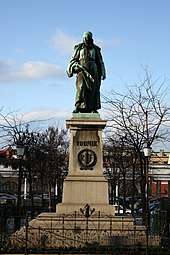
The renewal of Slovene sculpture begun with Alojz Gangl (1859–1935) who created sculptures for the public monuments of the Carniolan polymath Johann Weikhard von Valvasor and Valentin Vodnik, the first Slovene poet and journalist, as well as The Genius of the Theatre and other statues for the Slovenian National Opera and Ballet Theatre building.[294] The development of sculpture after World War II was led by a number of artists, including brothers Boris and Zdenko Kalin, Jakob Savinšek stayed with figural art. Younger sculptors, for example Janez Boljka, Drago Tršar and particularly Slavko Tihec, moved towards abstract forms. Jakov Brdar and Mirsad Begić returned to human figures.
- Graphics
During World War II, numerous graphics were created by Božidar Jakac, who helped establish the post-war Academy of Visual Arts in Ljubljana.

In 1917 Hinko Smrekar illustrated Fran Levstik's book about the well-known Slovene folk hero Martin Krpan. The children's books illustrators include a number of women illustrators, such as Marlenka Stupica, Marija Lucija Stupica, Ančka Gošnik Godec, Marjanca Jemec Božič, and Jelka Reichman.
- Painting
Historically, painting and sculpture in Slovenia was in the late 18th and the 19th century marked by Neoclassicism (Matevž Langus), Biedermeier (Giuseppe Tominz) and Romanticism (Mihael Stroj). The first art exhibition in Slovenia was organized in the late 19th century by Ivana Kobilica, a woman-painter who worked in realistic tradition. Impressionist artists include Matej Sternen, Matija Jama, Rihard Jakopič, Ivan Grohar whose The Sower (Slovene: Sejalec) was depicted on the €0.05 Slovenian euro coins, and Franc Berneker, who introduced the impressionism to Slovenia. Espressionist painters include Veno Pilon and Tone Kralj whose picture book, reprinted thirteen times, is now the most recognisable image of the folk hero Martin Krpan.[295] Some of the best known painters in the second half of the 20th century were Zoran Mušič, Gabrijel Stupica and Marij Pregelj.
- Photography
In 1841, Janez Puhar (1814–1864) invented a process for photography on glass, recognized on 17 June 1852 in Paris by the Académie Nationale Agricole, Manufacturière et Commerciale.[296] Gojmir Anton Kos was a notable realist painter and photographer between First World War and WW II.
The first photographer from Slovenia whose work was published by National Geographic magazine is Arne Hodalič.[297]
Sports

Slovenia is a natural sports venue, with many Slovenians actively practicing sports.[298] A variety of sports are played in Slovenia on a professional level,[299] with top international successes in handball, basketball, volleyball, association football, ice hockey, rowing, swimming, tennis, boxing, climbing, road cycling and athletics. Prior to World War II, gymnastics and fencing used to be the most popular sports in Slovenia, with champions like Leon Štukelj and Miroslav Cerar gaining Olympic medals for Slovenia. Association football gained popularity in the interwar period. After 1945, basketball, handball and volleyball have become popular among Slovenians, and from the mid-1970s onward, winter sports have, as well. Since 1992, Slovenian sportspeople have won 40 Olympic medals, including seven gold medals, and 22 Paralympic medals with four golds.
Individual sports are also very popular in Slovenia, including tennis and mountaineering, which are two of the most widespread sporting activities in Slovenia. Several Slovenian extreme and endurance sportsmen have gained an international reputation, including the mountaineer Tomaž Humar, the mountain skier Davo Karničar, the ultramarathon swimmer Martin Strel and the ultracyclist Jure Robič. Past and current winter sports Slovenian champions include Alpine skiers, such as Mateja Svet, Bojan Križaj, Ilka Štuhec and double olympic gold medalist Tina Maze, the cross-country skier Petra Majdič, and ski jumpers, such as Primož Peterka and Peter Prevc. Boxing has gained popularity since Dejan Zavec won the IBF Welterweight World Champion title in 2009. In cycling, Primož Roglič became the first Slovenian to win a Grand Tour when he won the 2019 Vuelta a Espana.
Prominent team sports in Slovenia include football, basketball, handball, volleyball, and ice hockey. The men's national football team has qualified for one European Championship (2000) and two World Cups (2002 and 2010). Of Slovenian clubs, NK Maribor played three times in the UEFA Champions League, and also three times in the UEFA Europa League. The men's national basketball team has participated at 13 EuroBaskets, winning the gold medal in the 2017 edition, and at three FIBA World Championships. Slovenia also hosted the EuroBasket 2013. The men's national handball team has qualified for three Olympics, eight IHF World Championships, including their third-place finish in the 2017 edition, and twelve European Championships. Slovenia was the hosts of the 2004 European Championship, where the national team won the silver medal. Slovenia's most prominent handball team, RK Celje, won the EHF Champions League in the 2003–04 season. In women's handball, RK Krim won the Champions League in 2001 and 2003. The national volleyball team has won the silver medal in the 2015 and 2019 editions of the European Volleyball Championship. The national ice hockey team has played at 27 Ice Hockey World Championships (with 9 appearances in top division), and has participated in the 2014 and 2018 Winter Olympic Games.
Notes
References
- "Census 2002: 7. Population by ethnic affiliation, Slovenia, Census 1953, 1961, 1971, 1981, 1991 and 2002". Statistical Office of the Republic of Slovenia. Retrieved 2 February 2011.
- "Prebivalstvo: demografsko stanje, jeziki in veroizpovedi". 10 October 2017.
- "Eurobarometer 90.4 (December 2018): Attitudes of Europeans towards Biodiversity, Awareness and Perceptions of EU customs, and Perceptions of Antisemitism", Special Eurobarometer, European Union: European Commission, 2019, retrieved 9 August 2019 – via GESIS
- Škrk, Mirjam (1999). "Recognition of States and Its (Non-)Implication on State Succession: The Case of Successor States to the Former Yugoslavia". In Mrak, Mojmir (ed.). Succession of States. Martinus Nijhoff Publishers. p. 5. ISBN 9789041111456.
- "Površina ozemlja in pokrovnost tal, določena planimetrično, 2005" [Surface area and land cover determined planimetrically, 2005] (in Slovenian and English). Statistical Office of the Republic of Slovenia. Retrieved 2 February 2011.
- "Population of Slovenia". Retrieved 17 June 2020.
- "World Economic Outlook Database, October 2019". IMF.org. International Monetary Fund. Retrieved 3 January 2020.
- "Gini coefficient of equivalised disposable income – EU-SILC survey". Eurostat. Retrieved 19 June 2020.
- "Key to HDI countries and ranks, 2015" (PDF). Hdr.undp.org. Retrieved 3 August 2017.
- Wells, John C. (2008). Longman Pronunciation Dictionary (3rd ed.). Longman. ISBN 9781405881180.
- Roach, Peter (2011). Cambridge English Pronouncing Dictionary (18th ed.). Cambridge: Cambridge University Press. ISBN 9780521152532.
- "Slovenski pravopis 2001: Slovenija".
- Slovene pronunciation: [ɾɛˈpùːblika slɔˈʋèːnija]. Source: "Slovenski pravopis 2001: Republika Slovenija".
- Slovene pronunciation: [ɾəˈsə́]. Source: "Slovenski pravopis 2001: Republika Slovenija".
- Černe, Andrej (2004). Orožen Adamič, Milan (ed.). Gateway to Western, Central, and Southeastern Europe (PDF). Slovenia: A Geographical Overview. Association of the Geographical Societies of Slovenia. p. 127. ISBN 961-6500-49-X.
For centuries, the territory of Slovenia has been crossed by traditional transportation routes connecting northern Europe with southern, eastern, and western Europe. Slovenia's location in the northwestern part of the Mediterranean's most inland bay on the Adriatic Sea where the Alps, the plateaus of the Dinaric Alps, and the western margins of the Pannonian Basin meet gives [it] a relatively quite advantageous traffic and geographical position distinguished by its transitional character and the links between these geographical regions. In the wider macroregional sense, this transitional character and these links have not changed since prehistoric times.
- Murovec, Nika; Kavaš, Damijan (December 2010). Introducing the National Context: Brief Presentation of the National Context (PDF). SWOT Analysis: Status of the Creative Industries in Ljubljana. Ljubljana: Inštitut za ekonomska raziskovanja [Institute for Economic Research]. p. 5. Archived from the original (PDF) on 8 March 2016.
For millennia, Slovenia has been at the crossroads of trade and cultural routes leading from north to south, from east to west.
- Nicoll, William; Schoenberg, Richard (1998). Europe beyond 2000: the enlargement of the European Union towards the East. Whurr Publishers. p. 121. ISBN 978-1-86156-064-3.
- "Population Number and Structure". Stat.si. Republic of Slovenia Statistical Office. 1 April 2019. Archived from the original on 29 June 2019. Retrieved 3 June 2020.
- Radonjić, Biljana (2005). "Political Overview". In Reuvid, Jonathan (ed.). Doing Business with Slovenia. ISBN 978-1-905050-70-3.
- "Slovenia First 20 Years". Slovenia: South Australia Newsletter. Winter 2010–2011. ISSN 1448-8175. Retrieved 25 November 2012.
- Vuk Dirnberk, Vojka; Tomaž Valantič. Statistični portret Slovenije v EU 2011 [Statistical Portrait of Slovenia in the EU 2011] (PDF) (in Slovenian and English). Statistical Office of the Republic of Slovenia. ISSN 1854-5734. Retrieved 2 February 2011.
- Perko, Drago (2008). "Slovenia at the Junction of Major European Geographical Units" (PDF). The Slovenian. Toronto: Vse Slovenski Kulturni Odbor [The All Slovenian Cultural Committee].
- Fallon, Steve (2007). "Environment". Slovenia (5 ed.). Lonely Planet. p. 40. ISBN 978-1-74104-480-5.
- Ogrin, Darko (2004). "Modern Climate Change in Slovenia" (PDF). In Orožen Adamič, Milan (ed.). Slovenia: A Geographical Overview. Association of the Geographical Societies of Slovenia. p. 45. ISBN 961-6500-49-X. Archived from the original (PDF) on 17 July 2013.
- Blažič, Mateja; Arih, Andrej; Nartnik, Irena; Turk, Inga (26 March 2008). "Endangered Species". Environmental Agency of the Republic of Slovenia, Ministry of the Environment and Spatial Planning. Retrieved 8 March 2012.
- Hlad, Branka; Skoberne, Peter, eds. (2001). "Characteristics of Biological and Landscape Diversity in Slovenia" (PDF). Biological and Landscape Diversity in Slovenia: An Overview. Ljubljana: Environmental Agency of the Republic of Slovenia, Ministry of the Environment and Spatial Planning. p. 13. ISBN 961-6324-17-9. Archived from the original (PDF) on 25 November 2012.
- "World Water Day 2011". Statistical Office of the Republic of Slovenia. 18 March 2011.
- "Country Introduction". European state of the environment 2010 – contributions from Slovenia. Environmental Agency of the Republic of Slovenia, Ministry of the Environment and Spatial Planning. Retrieved 8 March 2012.
- "Slovenian Forest in Figures". Slovenia Forest Service. February 2010. Archived from the original on 9 March 2012.
- Kladnik, Drago (2004). "Modern Climate Change in Slovenia" (PDF). In Orožen Adamič, Milan (ed.). Slovenia: A Geographical Overview. Association of the Geographical Societies of Slovenia. p. 93. ISBN 961-6500-49-X.
- "SOER: Country Introduction". Environment Agency of the Republic of Slovenia. Retrieved 3 February 2011.
- Vinkler, Jonatan (2008). Medkulturni dialog kot temeljna vrednota EU [Intercultural Dialogue as the Fundamental Value of the EU] (PDF) (in Slovenian and English). Faculty of Humanities Koper, University of Primorska. ISBN 978-961-92233-2-1. Archived from the original (PDF) on 4 March 2012.
- "Resolution on the National Security Strategy of the Republic of Slovenia" (PDF). National Assembly of the Republic of Slovenia. 21 June 2001. Archived from the original (PDF) on 14 April 2010. Retrieved 3 February 2011.
- Zupančič, Jernej (2004). "Ethnic Structure of Slovenia and Slovenes in Neighbouring Countries" (PDF). In Orožen Adamič, Milan (ed.). Slovenia: A Geographical Overview. Association of the Geographical Societies of Slovenia. p. 87. ISBN 961-6500-49-X.
- Martinšek, Maja (2007). Odnos med državo in religijo v Sloveniji [The Relationship Between the State and Religion in Slovenia] (PDF). Faculty of Humanities, University of Ljubljana. Archived from the original (PDF) on 21 February 2011. Retrieved 29 January 2011.
- Štrubelj, Dejan (2006). Primerjava narodne, verske in jezikovne sestave Slovenije: diplomsko delo [Comparison of Ethnic, Religious and Ethnic Structure of Slovenia: Diploma Thesis] (PDF) (in Slovenian). Faculty of Arts, University of Ljubljana. Archived from the original (PDF) on 11 May 2011. Retrieved 29 January 2011.
- Observatory of Economic Complexity, "Economy of Slovenia" Archived 23 December 2019 at the Wayback Machine, Observatory of Economic Complexity, 2017
- "Osnovni gospodarski podatki o Sloveniji" (in Slovenian). Embassy of the Republic of Slovenia Vienna. Archived from the original on 18 June 2012. Retrieved 15 March 2012.
- Wikipedia Economy of Slovenia Economy of Slovenia", "Economy of Slovenia", 2019
- Fajić, Lejla, ed. (September 2011). "Tabela 2b: Dodana vrednost po dejavnostih in bruto domači proizvod" [Table 2b: Added Value by Activities and Gross Domestic Product]. Jesenska napoved gospodarskih gibanj 2011: statistična priloga [Autumn Prediction of Economic Movements 2011: Statistical Appendix] (PDF) (in Slovenian). Ljubljana: Institute for Macroeconomic Analysis and Development (UMAR/IMAD), Republic of Slovenia. p. 45. Archived from the original (PDF) on 13 July 2012. Retrieved 12 April 2012.
- Sečen, Ernest (16 April 2005). "Mejo so zavarovali z žico in postavili mine" [They Protected the Border with Wire and Set up Mines]. Dnevnik.si (in Slovenian). Archived from the original on 21 March 2015. Retrieved 13 April 2012.
- P. Ramet, Sabrina (2008). "Democratization in Slovenia – The Third Stage". Serbia, Croatia and Slovenia at Peace and at War: Selected Writings, 1983–2007. LIT Verlag Münster. p. 272. ISBN 978-3-03735-912-9.
- Dutta, Manoranjan (2011). "Historical Progression of the EU". The United States of Europe: European Union and the Euro Revolution. 9781780523149. p. 31. ISBN 9781780523149.
- "Country and Lending Groups". World Bank.
- "Advanced economies". IMF. Retrieved 22 June 2019.
- "- Human Development Reports". hdr.undp.org.
- Kopač, Janez (2007). "Mesto kot upravnoteritorialna enota 1945–1955" [A Town as an Administrative–Territorial Unit]. Arhivi (in Slovenian and English). Arhivsko društvo Slovenije. 30 (2): 83. ISSN 0351-2835. COBISS 914293. Archived from the original on 31 August 2018. Retrieved 30 August 2018.
- Kopač, Janez (2001). "Ustava Socialistične republike Slovenije z dne 9. aprila 1963" [The Constitution of the Socialist Republic of Slovenia from 9 April 1963]. Arhivi (in Slovenian). XXIV (1): 1. Archived from the original on 3 March 2016. Retrieved 30 August 2018.
- "Milestones - slovenia.si". slovenia.si. Archived from the original on 22 February 2018. Retrieved 18 March 2018.
- Luthar, Oto (2008). "From Prehistory to the End of the Ancient World". The Land Between: A History of Slovenia. Peter Lang. p. 15. ISBN 978-3-631-57011-1.
- "Potočka zijavka". Parc.si. Palaeolithic Research Centre. Archived from the original on 3 October 2012.
- Debeljak, Irena; Turk, Matija. "Potočka zijalka". In Šmid Hribar; Mateja Torkar; Gregor Golež; Mateja Podjed; Dan. Drago Kladnik; Drago. Erhartič; Bojan Pavlin; Primož. Jerele, Ines. (eds.). Enciklopedija naravne in kulturne dediščine na Slovenskem – DEDI (in Slovenian). Archived from the original on 15 May 2012. Retrieved 12 March 2012.
- "The oldest wooden wheel in the world: Virtual exhibition". 4 January 2013. Archived from the original on 23 January 2013.
- Alexander Gasser (March 2003). "World's Oldest Wheel Found in Slovenia". Government Communication Office of the Republic of Slovenia. Archived from the original on 14 July 2012. Retrieved 19 August 2010.
- "Application for the Title of the European Capital of Culture 2012" (PDF). City Municipality of Maribor. 2008. Cite journal requires
|journal=(help) - Wolfram, Herwig (1997). The Roman Empire and Its Germanic Peoples. Berkeley, CA: University of California Press. p. 92.
- Singleton, Fred (1989). A Short History of the Yugoslav Peoples. Cambridge: Cambridge University Press. p. 2.
- Štih, Peter (2009). Na stičišču svetov: slovenska zgodovina od prazgodovinskih kultur do konca 18. stoletja [At the Junction of the Worlds: Slovene History from the Prehistoric Cultures to the End of the 18th Century] (in Slovenian). Modrijan Publishing House. p. 33. ISBN 978-961-241-375-0.
- "About Slovenia – Culture of Slovenia". Culture.si. Retrieved 2 June 2012.
- Lenček, Rado (1990). "Note: The Terms Wende – Winde, Wendisch – Windisch in the Historiographic Tradition of the Slovene Lands". Slovene Studies. 12 (1): 94. doi:10.7152/ssj.v12i1.3797.
- Benderly, Jill; Kraft, Evan (1996). "In the Beginning: The Slovenes from the Seventh Century to 1945". Independent Slovenia: Origins, Movements, Prospects. Palgrave Macmillan. pp. 9–11. ISBN 978-0-312-16447-8.
- Petra Svoljšak, Slovenski begunci v Italiji med prvo svetovno vojno (Ljubljana 1991).
- Lipušček, U. (2012) Sacro egoismo: Slovenci v krempljih tajnega londonskega pakta 1915, Cankarjeva založba, Ljubljana. ISBN 978-961-231-871-0
- Cresciani, Gianfranco (2004) Clash of civilisations, Italian Historical Society Journal, Vol. 12, No. 2, p. 4
- Mira Cencič, TIGR (Ljubljana: Mladinska knjiga, 1997)
- Tatjana Rejec, Pričevanja o TIGR-u (Ljubljana: Slovenska matica, 1995)
- Kranjec, Silvo (1925–1991). "Korošec Anton". Slovenski biografski leksikon (in Slovenian) (Online ed.). Slovenian Academy of Sciences and Arts. Archived from the original on 23 August 2011. Retrieved 24 July 2010.
- Gregor Joseph Kranjc (2013).To Walk with the Devil, University of Toronto Press, Scholarly Publishing Division, p. introduction 5
- Haar, I., Fahlbusch, M. (2006): German Scholars and Ethnic Cleansing, 1919–1945, Berghahn Books, ISBN 9781845450489, p. 115
- Lukšič-Hacin, M., Mlekuž J. (2009): Go Girls!: When Slovenian Women Left Home, Založba ZRC SAZU, ISBN 9789612541705, p. 55
- Zdravko Troha (2004). Kočevski Nemci – partizani [fotografije Zdravko Troha, Pokrajinski muzej Kočevje, Arhiv Slovenije]. Ljubljana: Slovensko kočevarsko društvo Peter Kosler. ISBN 961-91287-0-2
- Lumans, V.O. (1993):Himmler's Auxiliaries: The Volksdeutsche Mittelstelle and the German National Minorities of Europe, 1933–1945, Univ of North Carolina Press, ISBN 9780807820667, p. 175
- Jeffreys-Jones, R. (2013): In Spies We Trust: The Story of Western Intelligence, Oxford University Press, ISBN 9780199580972
- Adams, Simon (2005): The Balkans, Black Rabbit Books, ISBN 9781583406038
- Tomasevich, Jozo (2001). War and Revolution in Yugoslavia, 1941–1945: Occupation and Collaboration. 2. San Francisco: Stanford University Press. pp. 96–97. ISBN 0-8047-3615-4.
- Rusinow, Dennison I. (1978). The Yugoslav experiment 1948–1974. University of California Press. p. 2. ISBN 0-520-03730-8.
- "Slovene-Italian Relations 1880–1956 – Report of the Slovene-Italian historical and cultural commission".
- Zajc, Drago (2004). Razvoj parlamentarizma: funkcije sodobnih parlamentov [The Development of Parliamentarism: The Functions of Modern Parliaments] (PDF) (in Slovenian). Publishing House of the Faculty of Social Sciences, University of Ljubljana. p. 109. ISBN 961-235-170-8. Archived from the original (PDF) on 26 April 2012. Retrieved 27 December 2011.
- "Osamosvojitveni akti Republike Slovenije" (in Slovenian). Office for Legislation, Government of the Republic of Slovenia. Archived from the original on 17 January 2012. Retrieved 27 December 2011.
- Innovatif and ORG.TEND (14 May 1992). "Year 1990 | Slovenia 20 years". Twenty.si. Archived from the original on 11 June 2012. Retrieved 2 June 2012.
- "Odlok o razglasitvi ustavnih amandmajev k ustave Socialistične Republike Slovenije" (PDF). Uradni List Republike Slovenije (in Slovenian). 16 March 1990. Retrieved 27 December 2011.
- Felicijan Bratož, Suzana (2007). Prevzem arhivskega gradiva plebiscitnega referenduma o samostojnosti Republike Slovenije (PDF). 6. zbornik referatov dopolnilnega izobraževanja s področja arhivistike, dokumentalistike in informatike v Radencih od 28. do 30. marca 2007 (in Slovenian and English). Regional Archives Maribor. pp. 453–458. Archived from the original (PDF) on 13 November 2012.
- "Volitve" [Elections]. Statistični letopis 2011. Statistical Yearbook 2011. 15. Statistical Office of the Republic of Slovenia. 2011. p. 108. ISSN 1318-5403.
- Jonsson, Anna (2006). "Changing Concepts of Rights". In P. Ramet, Sabrina; Fink-Hafner, Danica (eds.). Democratic Transition in Slovenia: Value Transformation, Education, And Media. Texas A&M University Press. p. 75. ISBN 978-1-58544-525-7.
- Race, Helena (2005). "Dan prej" – 26. junij 1991: diplomsko delo (PDF) (in Slovenian). Faculty of Social Sciences, University of Ljubljana. Retrieved 3 February 2011.
- "About the Slovenian Military Forces: History". Slovenian Armed Forces, Ministry of Defence. Retrieved 3 February 2011.
- Bennett, Christopher (1995). "Slovenia Fights". Yugoslavia's Bloody Collapse: Causes, Course and Consequences. C. Hurst & Co. Publishers. p. 159. ISBN 978-1-85065-232-8.
- Klemenčič, Matjaž; Žagar, Mitja (2004). "Democratization in the Beginning of the 1990s". The Former Yugoslavia's Diverse Peoples: A Reference Sourcebook. ABC-CLIO. p. 298. ISBN 978-1-57607-294-3.
- Borak, Neven; Borak, Bistra (2004). "Institutional Setting for the New Independent State". In Mrak, Mojmir; Rojec, Matija; Silva-Jáuregui, Carlos (eds.). Slovenia: From Yugoslavia to the European Union. World Bank Publications. World Bank Publications. p. 58. ISBN 978-0-8213-5718-7.
- "Slovenia's accession to the OECD". OECD. 21 July 2010. Retrieved 22 July 2016.
- Joachim Becker: "Nujno je treba zavreti poglabljanje neoliberalizma v Evropski uniji, saj je to slepa ulica" Archived 7 May 2013 at the Wayback Machine, an interview with Joachim Becker, Mladina, 23 November 2012
- A Symposium of Law Experts. Political arbitrariness has gone wild. (In Slovene: "Posvet pravnikov. Samovolja politikov presega vse meje"), Dnevnik, 18 Januar 2013.
- Jenko, Marjan (2005). "O pomenu meridiana 15° vzhodno od Greenwicha" (PDF). Geodetski Vestnik (in Slovenian). 49 (4). pp. 637–638. Retrieved 5 January 2010.
- "Simboli in sestavine" (in Slovenian). GEOSS Society. Archived from the original on 1 April 2012. Retrieved 12 February 2012.
- Geografske koordinate skrajnih točk (in Slovenian and English). Statistical Office of the Republic of Slovenia. Retrieved 12 February 2012.
- Valantič, Tomaž (2010). "Slovenija v številkah" (PDF). Slovenija V Številkah (in Slovenian and English). Statistical Office of the Republic of Slovenia. ISSN 1318-3745. Retrieved 2 February 2011.
- "In 2016, forest covered 58.3% of Slovenia". Statistical Office of the Republic of Slovenia. 27 September 2017.
- "Forestation and variety of forests". Slovenia Forest Service. 2009. Archived from the original on 10 April 2011. Retrieved 2 February 2011.
- "Seismology". Retrieved 30 July 2008.
- Perko, Drago (1998). "The Regionalization of Slovenia" (PDF). Geografski zbornik. 38. pp. 11–57. ISSN 0373-4498. COBISS 10668077. Archived from the original (PDF) on 1 June 2013.
- Ogrin, Darko (August 2004). "Modern climate change in Slovenia" (PDF). Slovenia: a geographical overview. Association of the Geographical Societies of Slovenia. Archived from the original (PDF) on 20 August 2006. Retrieved 1 April 2008.
- "Natura 2000 in Slovenia". natura2000.gov.si. Archived from the original on 14 May 2011. Retrieved 1 February 2011.
- "2012 EPI :: Rankings | Environmental Performance Index". Epi.yale.edu. Archived from the original on 5 May 2012. Retrieved 25 November 2012.
- Tanja Cegnar. "Climate of Slovenia at Glance" (PDF). Arso.gov.si. Retrieved 25 November 2012.
- "National Meteorological Service of Slovenia – Archive". Meteo.si. Archived from the original on 18 June 2012. Retrieved 2 June 2012.
- "Kotišče ciklonov v zavetrju Alp". Archived from the original on 4 September 2015. Retrieved 19 August 2015.
- Bertalanič, Renato (2003). "Značilnosti vetra v Sloveniji" [Characteristics of Wind in Slovenia]. Klimatografija Slovenije (PDF) (in Slovenian). Meteorology Office, Slovenian Environment Agency. Archived from the original (PDF) on 9 February 2006.
- Vodno bogastvo Slovenije: tekoče vode (PDF). Slovenian Environment Agency. Retrieved 17 May 2012.
- Ambrožič, Špela; et al. (March 2008). "Water Quality in Slovenia" (PDF). ENVIRONMENTAL AGENCY OF THE REPUBLIC OF SLOVENIA. Retrieved 19 August 2015.
- "List of Parties". Retrieved 8 December 2012.
- Hlad, Branka; Skoberne, Peter, eds. (2001). "Characteristics of Biological and Landscape Diversity in Slovenia" (PDF). Biological and Landscape Diversity in Slovenia: An Overview. Ljubljana: Environmental Agency of the Republic of Slovenia, Ministry of the Environment and Spatial Planning. p. IX. ISBN 961-6324-17-9. Archived from the original (PDF) on 25 November 2012.
- "European Day of Parks 2012". News. Statistical Office of the Republic of Slovenia.
- "Did you know... – Slovenia – Official Travel Guide". Slovenia.info. Archived from the original on 29 January 2013. Retrieved 25 November 2012.
- Perko, Franc, ed. (2008). "Habitats of wild game in Slovenia, guidelines and conditions for the preservation and protection of wild game and their habitats, and provision of coexistence with humans". Resolution on National Forest Programme. Federation of Forest Associations of Slovenia. Ministry of Agriculture, Forestry and Food, Slovenia. pp. 87–104. Archived from the original on 8 September 2012.
- Peršak, Magda (30 September 1998). "Dormouse Hunting as Part of Slovene National Identity". Natura Croatica. 7 (3). pp. 199–211. ISSN 1330-0520. Archived from the original on 12 June 2012. Retrieved 4 February 2012.
- "Ris v Sloveniji (Lynx in Slovenia)" (PDF). Strategija ohranjanja in trajnostnega upravljanja navadnega risa (Lynx lynx) v Sloveniji 2016–2026. Ministry of Environment and Spatial Planning, Government of the Republic of Slovenia. 2016. p. 7. Archived from the original (PDF) on 14 October 2017. Retrieved 8 July 2017.
- "Risom v Sloveniji in na Hrvaškem se obeta svetlejša prihodnost". Delo.si (in Slovenian). 14 April 2017.
- Krofel, Miha (2009). "Confirmed presence of territorial groups of golden jackals (Canis aureus) in Slovenia" (PDF). Natura Sloveniae: Journal of Field Biology. 11 (1). Association for Technical Culture of Slovenia. pp. 65–68. ISSN 1580-0814. Archived from the original (PDF) on 21 February 2011. Retrieved 18 January 2011.
- Trček, Petra (14 March 2017). "Pri nas živi okoli 52 volkov, večina na Notranjskem in Kočevskem". Notranjskoprimorske novice (in Slovenian). Archived from the original on 15 March 2017. Retrieved 14 March 2017.
- "Koliko medvedov živi v Sloveniji?" (in Slovenian). Finance.si. 23 September 2011. Archived from the original on 17 August 2014. Retrieved 18 January 2012.
- "Medveda znamo držati nazaj, volka še ne". Dnevnik (in Slovenian). Dnevnik, d. d. 18 January 2012.
- Hlad, Branka; Skoberne, Peter, eds. (2001). "Karst and Subterranean Habitats" (PDF). Biological and Landscape Diversity in Slovenia: An Overview. Ljubljana: Environmental Agency of the Republic of Slovenia, Ministry of the Environment and Spatial Planning. p. 50. ISBN 961-6324-17-9. Archived from the original (PDF) on 25 November 2012.
- "Delfini pri nas" (in Slovenian). Morigenos. Retrieved 6 April 2006.
- "Puška poči, vrana pade. Koliko jih še sedi?". Vecer.Com. 9 February 2010. Archived from the original on 5 February 2013. Retrieved 2 June 2012.
- Kompan, Dragomir; et al. (May 2011). Program varstva biotske raznovrstnosti v živinoreji: program za leto 2011 (PDF) (in Slovenian). Oddelek za zootehniko, Biotehniška fakulteta, Univerza v Ljubljani [Department of Zootechnics, Biotechnical Faculty, University of Ljubljana]. Archived from the original (PDF) on 14 October 2017. Retrieved 22 January 2019.
- Meglič, Vladimir; Kraigher, Hojka; Dovč, Peter (2003). "Opis obstoječih zbirk" [Description of Extant Collections]. In Meglič, Vladimir (ed.). Ocena pogojev in mehanizmov za ex-situ varstvo genskih virov kmetijskih rastlin, genskih bank v gozdarstvu in živinoreji (PDF) (in Slovenian). Ministry of Environment and Space, Republic of Slovenia. p. 17. COBISS 1184678. Retrieved 16 March 2012.
- "Brief Historical Summary, breed standard (DOC file)". Archived from the original on 20 June 2012. Retrieved 2 June 2012.
- Janko Spreizer, Alenka (2006). "Avtohtonost v slovenskem narod(nost)nem vprašanju in koncept staroselstva: nastavki za analizo ideologij primata" (PDF). Razprave in Gradivo (in Slovenian). Ljubljana: Inštitut za narodnostna vprašanja [Institute for Ethnic Studies]: 257–258. ISSN 1854-5181. Archived from the original (PDF) on 10 May 2012. Retrieved 16 March 2012.
|section=ignored (help) - "Marble trout (Salmo marmoratus)". balkan-trout.com, Balkan Trout Restoration Group. Archived from the original on 23 September 2015. Retrieved 10 March 2009.
- Dušan Jurc, Andrej Piltaver & Nikica Ogris. Glive Slovenije – Fungi of Slovenia (Ljubljana, 2005). 497 pp.
- Golob A. "Forests and forestry in Slovenia". FAO. Archived from the original on 25 March 2009. Retrieved 7 May 2009.
- "In 2016, forest covered 58.3% of Slovenia". Statistical Office of the Republic of Slovenia. 27 September 2017.
- Lovrenčak, Franc (2007). Zgornja gozdna meja slovenskih Alp, visokih kraških planot in Prokletij. Faculty of Arts, University of Ljubljana. ISBN 978-961-6648-11-0. Archived from the original on 22 May 2013.
- Kala, C.P.; Ratajc, P. (2012). "High altitude biodiversity of the Alps and the Himalayas: ethnobotany, plant distribution and conservation perspectives". Biodiversity and Conservation. 21 (4): 1115–1126. doi:10.1007/s10531-012-0246-x.
- Furtlehner, Petra (2008). "Slovenia". In Falkner, Gerda; Treib, Oliver; Holzleithner, Elizabeth (eds.). Compliance in the Enlarged European Union: Living Rights Or Dead Letters?. Ashgate Publishing, Ltd. pp. 126–127. ISBN 978-0-7546-7509-9.
- Šturm, Lovro (2006). "Slovenia". In Robbers, Gerhard (ed.). The President of the Republic. Encyclopedia of World Constitutions. Infobase Publishing. p. 832. ISBN 978-0-8160-6078-8.
- Prunk, Janko; Pikalo, Jernej; Milosavljevič, Marko (2007). Facts about Slovenia. Government Communication Office, Government of the Republic of Slovenia. p. 23. ISBN 978-961-6435-45-1.
- "Življenje Janeza Drnovška :: Prvi interaktivni multimedijski portal, MMC RTV Slovenija". Rtvslo.si. Retrieved 2 June 2012.
- P. Ramet, Sabrina; Fink-Hafner, Danica (15 September 2006). "Key Trends in Slovenian Politics, 1988 – 2004". Democratic Transition in Slovenia: Value Transformation, Education, And Media. p. 30. ISBN 9781585445257.
- Ágh, Attila (1998). "The Regions in Comparative Transition". The Politics of Central Europe. SAGE. ISBN 978-0-7619-5032-5.
- Pavlovčič, Idija (4 September 2015). "Jože P. Damijan: Levica in desnica podpirali menedžerske prevzeme". Delo d.d. Retrieved 6 September 2015.
- "Sprejet zakon". .gov.si. 13 July 2000. Retrieved 2 June 2012.
- Repe, Božo (2003) Od deželana do državljana: Regionalni razvoj Slovencev v letih 1918–1991 Archived 23 February 2013 at the Wayback Machine, Zgodovinski časopis, 3–4, Ljubljana.
- Mehle Mihovec, Barbka (19 March 2008). "Kje so naše meje?". Gorenjski glas. Archived from the original on 19 December 2018. Retrieved 19 December 2018.
- "Regions in the European Union: Nomenclature of territorial units for statistics" (PDF). European Commission. Archived from the original (PDF) on 21 February 2011. Retrieved 25 November 2012.
- Central Intelligence Agency (2009). The CIA World Factbook 2010. Skyhorse Publishing Inc. p. 617. ISBN 978-1-60239-727-9.
- "International Cooperation". Slovenian Armed Forces. Retrieved 15 February 2011.
- "Republic of Slovenia : 2017 Article IV Consultation-Press Release; Staff Report; and Statement by the Executive Director for the Republic of Slovenia". IMF.org. International Monetary Fund. 15 May 2017. Retrieved 11 July 2018.
- "GDP per capita in PPS, Eurostat". Retrieved 1. June 2015.
- The World Bank: the human capital index (HCI), 2018. Retrieved 8. October 2019.
- M. Magstadt, Thomas (2010). "Eastern Europe". Nations and Government: Comparative Politics in Regional Perspective (6th ed.). Cengage Learning. p. 27. ISBN 978-0-495-91528-7.
- "Regional Disparities in Slovenia 2/12"; retrieved 8 April 2015.
- Jože Mencinger (2011) Razprodaja?, Gospodarska gibanja, EIPF, Ljubljana Archived copy at WebCite (23 April 2013).
- "Slovenia's Economy: Next in Line". The Economist. 18 August 2012. Retrieved 22 August 2012.
- "Double Dip Recession is the 'Slovenian' Reality". The Slovenia Times. 13 March 2012.
- Naidu-Ghelani, Rajeshni (23 January 2012). "Countries with Aging Populations". CNBC. Archived from the original on 23 February 2013.
- "Statistics Office to Release GDP Data for Q2". The Slovenia Times. 31 August 2012.
- Cerni, Boris (29 February 2012). "Slovenia's Economy Falls into a Recession as Exports Weaken". Bloomberg.
- "Zdrs v recesijo so ekonomisti pričakovali". MMC RTV Slovenija (in Slovenian). RTV Slovenija. 29 February 2012. ISSN 1581-372X.
- MacDowall, Andrew (15 July 2015). "How Slovenia turned itself around". Politico Europe. Retrieved 18 July 2017.
- "GDP up by 6.0% in the fourth quarter of 2017 and by 5.0% in 2017 – Statistical Office of the Republic of Slovenia". Retrieved 5 December 2018.
- Garaca, Maja (14 June 2017). "Tourism contributes 3.5% directly to Slovenia's GDP in 2016 – WTTC". seenews.com. Archived from the original on 3 August 2017. Retrieved 18 July 2017.
- "Net lending (+) / net borrowing (-) and consolidated gross debt of general government by CATEGORY, MEASURES and YEAR". PX-Web. Retrieved 7 December 2019.
- "The World Factbook". Central Intelligence Agency, United States. 23 February 2012. Economy.
- "Dr. Pavle Sicherl: Slovenija je po produktivnosti dela 23 let za Evropo". Delo.si (in Slovenian). 8 August 2011. ISSN 1854-6544. Archived from the original on 25 February 2012. Retrieved 12 April 2012.
- "Konkurenčnost slovenske industrije pod evropskim povprečjem". Delo.si (in Slovenian). 14 October 2011. ISSN 1854-6544. Archived from the original on 15 October 2011. Retrieved 12 April 2012.
- "The World Factbook 2007 – Slovenia, Economy".
- Perše, Simon; Štuhec Lončarević, Snježana; Kozar, Alenka; Urbiha, Almira; Živec, Jana; Mušić, Amira (January 2012). Slovenia'S Trade in Goods / In The 2000–2010 Period (PDF). p. 20. ISBN 978-961-239-240-6.
- "Gorenje, Krka Biggest Exporters of 2012" Archived 16 April 2017 at the Wayback Machine. Retrieved 16 April 2017.
- "18 Slovenian Firms in Deloitte Central Europe Top 500" Archived 16 April 2017 at the Wayback Machine. Retrieved 16 April 2017.
- Viršek, Damjan (28 May 2018). "FOTO:Petrol prvi, sledi mu Gen-I". delo.si (in Slovenian). Retrieved 7 December 2019.
- "POROČILO O STANJU NA PODROČJU ENERGETIKE V SLOVENIJI (page 18)". agen-rs.si/. Retrieved 1 November 2019.
- "News – Šoštanj Thermal Power Plant". te-sostanj.si. Archived from the original on 25 February 2019. Retrieved 24 February 2019.
- "POROČILO O STANJU NA PODROČJU ENERGETIKE V SLOVENIJI 2018 (page 11)". agen-rs.si. Retrieved 5 April 2020.
- Horvat, Uroš (2004). "Tourism in Slovenia" (PDF). In Orožen Adamič, Milan (ed.). Slovenia: A Geographical Overview. Association of the Geographical Societies of Slovenia. p. 146. ISBN 961-6500-49-X.
- "This Is the World's Most Sustainable Country". National Geographic Society. Retrieved 23 August 2018.
- Podoba Plečnikove Ljubljane Archived 3 September 2011 at the Wayback Machine
- "Active holidays – Slovenia – Official Travel Guide". Slovenia.info. Archived from the original on 26 May 2012. Retrieved 2 June 2012.
- "Občina Piran-O občini". Piran.si. Archived from the original on 13 May 2012. Retrieved 2 June 2012.
- Katz, Liane (23 June 2006). "Detox, retox in Slovenia". The Guardian. London.
- "15 Spas in Slovenia, Official Travel Guide". Slovenia.info. Retrieved 7 August 2012.
- "Architectural Heritage – Slovenia – Official Travel Guide". Slovenia.info. Archived from the original on 4 April 2012. Retrieved 2 June 2012.
- "Castles – Slovenia – Official Travel Guide". Slovenia.info. Retrieved 2 June 2012.
- "Slovenia photo gallery – pictures, facts and information on Slovenia". Earthinpictures.com. Archived from the original on 22 June 2012. Retrieved 2 June 2012.
- "East Europe Casinos and Gambling". Worldcasinodirectory.com. Archived from the original on 22 September 2012. Retrieved 8 September 2012.
- "I Feel Slovenia: 2010" (PDF). Slovenia.info. Archived from the original (PDF) on 10 May 2012. Retrieved 25 November 2012.
- "Slovenia declared world's first green country". Sloveniatimes.com. Archived from the original on 3 August 2017. Retrieved 3 August 2017.
- "Slovenia, a Country at the Crossroads of Transport Links". Government Communication Office, Republic of Slovenia. November 2000. Archived from the original on 8 July 2012.
- "Teden mobilnosti 2009". Statistical Office of the Republic of Slovenia. 15 September 2009.
- Bernard Vukadin, Barbara; Kušar, Urška; Burja, Alenka (25 October 2009). "Lastništvo avtomobilov v gospodinjstvih" (in Slovenian). Environment Agency of Slovenia.
- "Situation per mode of transport" (PDF). Study on Strategic Evaluation on Transport Investment Priorities under Structural and Cohesion funds for the Programming Period 2007–2013. ECORYS Nederland BV. August 2006.
- Oplotnik, Žan; Križanič, France (November 2004). "National motorway construction program (NMCP) in Slovenia (financing, impact on national economy and realization)" (PDF). Highways: cost and regulation in Europe. Archived from the original (PDF) on 20 November 2012.
- Gabrijelčič, Peter (October 2010). "Narodnogospodarske koristi in razvojne možnosti prometnih sistemov v RS" (PDF). 10th Slovenian Road and Transport Congress (in Slovenian and English).
- Plevnik, Aljaž; Polanec, Vesna (18 November 2011). "Vlaganja v prometno infrastrukturo: Komentar" (in Slovenian). Slovenian Environment Agency.
- "Za razvoj Slovenije | Drugi tir". www.drugitir.si. Archived from the original on 3 March 2019. Retrieved 24 February 2019.
- "Executive Summary" (PDF). Analysis of the infrastructure network in Slovenia and report on SWOT analysis. Faculty of Chemistry and Chemical Engineering, University of Maribor. Port of Koper. April 2011. Archived from the original (PDF) on 10 May 2012. Retrieved 8 February 2012.
- Plevnik, Aljaž; Polanec, Vesna (18 November 2011). "Obseg in sestava blagovnega prevoza in prometa: Komentar". Slovenian Environment Agency.
- Luz, D. D. (March 2010). Državni prostorski načrt za Ljubljansko železniško vozlišče (PDF) (in Slovenian). Archived from the original (PDF) on 8 July 2012.
- "Koper Port Hits Record High in Container Traffic". Green Med Journal. 21 November 2011. Archived from the original on 25 November 2011. Retrieved 7 February 2012.
- "Konecranes to deliver three further RTGs to Luka Koper". Port Technology International. 23 January 2012. Archived from the original on 18 May 2012. Retrieved 7 February 2012.
- Twrdy, Elen; Trupac, Igor. "Container Boom in the Port of Koper". European Conference on Shipping & Ports 2011: Proceedings. ISBN 978-960-93329-5-8.
- Gosar, Anton (2008). "Sodobne pol1t1čno-geografske značilnosti alpsko-jadranskega prostora brez meja". Acta Histriae (in Slovenian, English, and Italian). 16 (3). Archived from the original on 25 October 2013.
- "Transport" (PDF). Statistične informacije [Rapid Reports] (21): 11. 4 November 2011.
- "Resolucija o nacionalnem programu razvoja pomorstva Republike Slovenije" (PDF) (in Slovenian). Ministry of Transport, Republic of Slovenia. 3 November 2010. Archived from the original (PDF) on 10 May 2012. Retrieved 7 February 2012.
- "Edini slovenski ladjar praznuje". MMC RTV Slovenija. 22 October 2004. ISSN 1581-372X.
- "Transport" (PDF). Statistične informacije [Rapid Report] (26). 22 November 2010.
- Information Booklet (PDF). Aerodrom Ljubljana. 2011. Archived from the original (PDF) on 10 May 2012. Retrieved 7 February 2012.
- Konda, Jože (2006). "Cerklje Airport on its way to future growth" (PDF). Slovenska Vojska. XIV (8). p. 29. ISSN 1580-1993. Archived from the original (PDF) on 10 May 2012. Retrieved 7 February 2012.
- "30.9 Gostota naseljenosti 1.7 – Population Density, 1 July". Stat.si. Archived from the original on 26 August 2013. Retrieved 25 November 2012.
- Zupanič, Milena (20 June 2011). "Demografski preobrat: tiha revolucija med nami". Delo.si (in Slovenian). Delo, d. d. ISSN 1854-6544.
- Hlebec, Valentina; Šircelj, Milivoja (September 2011). "Population Ageing in Slovenia and Social Support Networks of Older People". In Hoff, Andreas (ed.). Population Ageing in Central and Eastern Europe: Societal and Policy Implications. Ashgate Publishing, Ltd. pp. 118–119. ISBN 978-0-7546-7828-1.
- "Strong Growth but an Ageing Workforce". Slovenia. OECD Publishing. July 2009. p. 34. ISBN 978-92-64-06894-0.
- .https://www.cia.gov/library/publications/the-world-factbook/geos/si.html
- "Births, Slovenia, 2016". Stat.si. Retrieved 3 August 2017.
- "Health status – Life expectancy at birth – OECD Data". theOECD. Archived from the original on 11 August 2019. Retrieved 23 September 2019.
- "World Suicide Prevention Day 2010". Statistical Office of the Republic of Slovenia. 8 September 2010. Archived from the original on 13 November 2010. Retrieved 14 September 2010.
- "World Suicide Prevention Day 2011". Statistical Office of the Republic of Slovenia. 8 September 2011.
- Bole, David (2008). Ekonomska preobrazba slovenskih mest. ISBN 978-961-254-090-6.
- "Projekt statistike razvoja podeželja". Statistical Office RS. Retrieved 20 September 2013.
- Zavodnik Lamovšek, Alma; Drobne, Samo; Žaucer, Tadej (2008). "Small and Medium-Size Towns as the Basis of Polycentric Urban Development" (PDF). Geodetski Vestnik. 52 (2). Association of Surveyors of Slovenia. p. 303. ISSN 0351-0271.
- ":: Statistical Office of the Republic of Slovenia – How frequent are the same names of settlements and streets? ::". Stat.si. Retrieved 2 June 2012.
- "Slovenščina materni jezik za 88 odstotkov državljanov". Siol. 19 February 2009. Archived from the original on 16 May 2012. Retrieved 2 June 2012.
- Šircelj, Milivoja (2003). Verska, jezikovna in narodna sestava prebivalstva Slovenije: Popisi 1921–2002 (PDF) (in Slovenian). Statistični urad Republike Slovenije. ISBN 961-239-024-X.
- "Linguist Says Slovenian Language Not Endangered". Slovenian Press Agency. 21 February 2010.
- "International Mother Language Day". Statistical Office of the Republic of Slovenia. 19 February 2009. Archived from the original on 13 November 2010. Retrieved 3 February 2011.
- McDonald, Gordon C. 1979. Yugoslavia: A Country Study. Washington, DC: American University, p. 93
- Greenberg, Marc L. 2009. "Slovene." In Keith Brown & Sarah Ogilvie (eds.), Concise Encyclopedia of Languages of the World, pp. 981–984. Oxford: Elsevier, p. 981.
- Brown, E. K. & Anne Anderson. 2006. Encyclopedia of Language & Linguistics: Sca-Spe. Oxford: Elsevier, p. 424
- Sussex, Roland, & Paul V. Cubberley. 2006. The Slavic languages. Cambridge: Cambridge University Press, p. 502.
- Sławski, Franciszek. 1962. Zarys dialektologii południowosłowiańskiej. Warsaw: PAN.
- Priestly, Tom M. S. (1993). "On 'Drift' in Indo-European Gender Systems". Journal of Indo-European Studies. 11: 339–363.
- Klopčič, Vera (2007). "Legal Protection of Roma in Slovenia" (PDF). Treatises and Documents: Journal of Ethnic Studies. Institute for Ethnic Studies (52): 234–255. ISSN 1854-5181. Archived from the original (PDF) on 21 February 2011. Retrieved 3 February 2011.
- Klopčič, Vera; Miroslav Polzer (2003). Evropa, Slovenija in Romi (PDF) (in Slovenian). Institute for Ethnic Studies. ISBN 961-6159-23-2. Archived from the original (PDF) on 21 February 2011. Retrieved 3 February 2011.
- "Granish – a Minority Language Spoken in Slovenia". Norway.si. Retrieved 2 June 2012.
- European Day of Languages Archived 24 January 2013 at the Wayback Machine, Eurostat Newsrelease, 24 September 2009
- "Special Eurobarometer 386 Europeans and Their Languages" (PDF). June 2012. Retrieved 18 October 2013.
- "Eurobarometer pool (2006), page 152" (PDF). Retrieved 2 June 2012.
- "SI-Stat Data Portal". SURS. Archived from the original on 13 June 2017. Retrieved 19 June 2017.
- Medvešek, Mojca (2007). "Kdo so priseljenci z območja nekdanje Jugoslavije" (PDF). Razprave in Gradivo (in Slovenian) (53–54). Institute for Ethnic Studies. p. 34. Archived from the original (PDF) on 21 February 2011. Retrieved 29 January 2011.
- Repolusk, Peter (2006). "Narodnostno neopredeljeno prebivalstvo ob popisih 1991 in 2002 v Sloveniji" (PDF). Dela (in Slovenian and English). 25. Anton Melik Geographical Institute. pp. 87–96. Archived from the original (PDF) on 6 March 2012.
- "International Mother Language Day 2010". Statistical Office of the Republic of Slovenia. 19 February 2010. Archived from the original on 13 November 2010. Retrieved 29 January 2011.
- "Constitution of the Republic of Slovenia". National Assembly of the Republic of Slovenia. Archived from the original on 23 December 2010. Retrieved 26 January 2011.
- Šabec, Ksenija (2009). Poročilo: Italijanska narodna skupnost v Slovenski Istri (PDF) (in Slovenian). Center for Cultural and Religious Studies, University of Ljubljana. p. 7. Archived from the original (PDF) on 11 May 2011. Retrieved 1 February 2011.
- Gajšek, Nina (2004). Pravice romske skupnosti v Republiki Sloveniji (PDF) (in Slovenian). Faculty of Social Science, University of Ljubljana. Archived from the original (PDF) on 21 February 2011. Retrieved 1 February 2011.
- Zupančič, Jernej (2007). "Romska naselja kot poseben del naselbinskega sistema v Sloveniji" (PDF). Dela (in Slovenian and English). 27. Institute of Geography. pp. 215–246. Archived from the original (PDF) on 6 March 2012.
- "Statistični urad RS – Selitveno gibanje, Slovenija, 2007". Stat.si. Archived from the original on 6 July 2012. Retrieved 2 June 2012.
- "Slovenian Americans – History, Modern era, The first slovenians in america, Settlement".
- Source: Statistical Office of the Republic of Slovenia, Census of Population, Households and Housing, 2002.
- "Uskoška dediščina Bele krajine na RTVS|Ljudje|Lokalno aktualno". Lokalno.si. 6 January 2012. Retrieved 2 June 2012.
- Source:name="EB2018">"Eurobarometer 90.4 (December 2018): Attitudes of Europeans towards Biodiversity, Awareness and Perceptions of EU customs, and Perceptions of Antisemitism", Special Eurobarometer, European Union: European Commission, 2019, retrieved 9 August 2019 – via GESIS
- "Predstavitev". Evang-cerkev.si. Archived from the original on 10 June 2012. Retrieved 2 June 2012.
- "Islamska Skupnost v Republiki Sloveniji". Islamska-skupnost.si. Archived from the original on 19 March 2012. Retrieved 2 June 2012.
- "The Virtual Jewish History Tour – Slovenia". Jewishvirtuallibrary.org. 4 March 2003. Retrieved 2 June 2012.
- "Special Eurobarometer, biotechnology, page 204" (PDF). 2010 [Fieldwork: Jan–Feb 2010].
- "Table: Range of rank on the PISA 2006 science scale" (PDF). PISA 2006. OECD. 4 December 2007. Retrieved 15 April 2008.
- OECD. "Slovenia – OECD Better Life Index". Oecdbetterlifeindex.org. Retrieved 25 November 2012.
- "About Slovenia – Culture of Slovenia". Culture.si. Retrieved 2 June 2012.
- Archived 21 February 2012 at the Wayback Machine
- "Statistics (by Country) of Academic Ranking of World Universities | Shanghai Ranking". ARWU. Retrieved 2 June 2012.
- "University of Ljubljana once again on Shanghai and Webometrics ranking lists". Uni-lj.si. Retrieved 4 April 2014.
- "Univerza v Mariboru". Uni-mb.si. Retrieved 2 June 2012.
- "Univerza na Primorskem: SLO". Upr.si. Retrieved 2 June 2012.
- "Univerza v Novi Gorici". Ung.si. Retrieved 2 June 2012.
- "EMUNI University". Archived from the original on 22 February 2011. Retrieved 13 February 2011.
- Smrekar, Andrej. "Slovenska moderna" (in Slovenian). National Gallery of Slovenia. Archived from the original on 26 October 2013.
- Naglič, Miha (6 June 2008). "Je človek še Sejalec". Gorenjski glas (in Slovenian). Archived from the original on 8 February 2013.
- "Pogled na ...: Ivan Grohar, Sejalec" (in Slovenian). RTV Slovenija. 4 December 2007. Archived from the original on 5 September 2012.
- Planet, Lonely; Bain, Carolyn; Fallon, Steve (1 May 2016). Lonely Planet Slovenia. Lonely Planet. p. 498. ISBN 978-1-76034-148-0.
- "Škocjan Caves mark 30th anniversary of UNESCO listing". The Slovenia Times. Retrieved 21 May 2020.
- Budja, Mihael; Mlekuz, Dimitrij (2010). "Lake or Floodplain? Mid-Holocene Settlement Patterns and the Landscape Dynamic of the Izica Floodplain (Ljubljana Marshes, Slovenia)". The Holocene. 20 (8): 1269. doi:10.1177/0959683610371998.
- "WebCite query result". Archived from the original on 14 October 2017. Retrieved 1 March 2015.
- Umrl baletnik Pino Mlakar, Dnevnik, 2 October 2006
- Pia and Pino Mlakar Archived 6 June 2019 at the Wayback Machine, The Slovenian National Theatre Opera and Ballet Ljubljana website
- Branko Miklavc: Na konec sveta bom potoval, samo da ju še enkrat vidim plesati, Dnevnik, 7 October 2006
- Nika Arhar: Uprizarjanje zgodovine sodobnega plesa, MMC RTVSLO, 25 December 2015
- Ljubljana Jazz Festival Archived 23 July 2012 at the Wayback Machine, an official site (in English)
- Museum of Slovene Film Actors, Divača, official website.
- "Umrl je Polde Bibič, starosta slovenskega igralskega ceha". Prvi interaktivni multimedijski portal, MMC RTV Slovenija (in Slovenian). 13 July 2012.
- Furlan, S. (1994) Filmografija slovenskih celovečernih filmov: 1931 – 1993. Slovenski gledališki in filmski muzej. Ljubljana.
- "Boris Pahor je ime leta po izboru Vala 202 :: Prvi interaktivni multimedijski portal, MMC RTV Slovenija". Rtvslo.si. Retrieved 9 March 2012.
- "Mladinska knjiga – Iz medijev". Mladinska.com. 26 August 2009. Archived from the original on 3 March 2012. Retrieved 9 March 2012.
- Oto Luthar The land between: a history of Slovenia
- George J. Buelow (2004) A History of Baroque Music, p. 701.
- Neža Loštrek, A Short Guide to Slovenian Oompah Music" Total Slovenian News (3 Jan 2018): https://www.total-slovenia-news.com/lifestyle/316-a-short-guide-to-slovenian-oompah-music; and Rick March and Dick Blau, Polka Heartland: Why the Midwest Loves to Polka (Madison: Wisconsin Historical Society, 2015), 169. https://books.google.com/books?id=6VdjCgAAQBAJ&pg=PT169 and ISBN 0870207237
- Slovenska popevka: velik poudarek na pevcih in skladateljih, pesniki bolj v oklepaju. Enkrat še zapoj: 50 let Slovenske popevke Vladimirja Frantarja pri celjski Mohorjevi družbi., Delo, 5. September 2012.
- Perpetuum Jazzile: Africa on YouTube. Retrieved 9 September 2013.
- "Perpetuum Jazzile Official Web Site". 7 July 2009. Archived from the original on 13 August 2009. Retrieved 17 July 2009.
- 15 years of Mi2 band, Delo, 26 October 2010
- "WALKING DEAD ON BROADWAY – to support WITHIN DESTRUCTION in March! – Arising Empire". arising-empire.com. Archived from the original on 2 February 2018. Retrieved 2 February 2018.
- Pripotovanje hrepenenca — Tomaž Pengov, kantavtor Archived 5 April 2011 at the Wayback Machine, Mladina, 3 March 2007
- Štravs, Smilja (8 April 2011). "Vurnikova hiša na Miklošičevi: najlepša hiša v Ljubljani". Delo.si (in Slovenian). Delo, d. d. ISSN 1854-6544.
- "Razstava UZNLB v Bruslju – NLB". Nlb.si. Archived from the original on 28 April 2009. Retrieved 2 June 2012.
- "Kiparstvo 19. in 20. stoletja". Archived from the original on 1 October 2006. Retrieved 1 March 2015.
- Archived 23 July 2004 at the Wayback Machine
- "Life and work of Janez Puhar | (accessed December 13, 2009)". Archived from the original on 11 May 2013. Retrieved 22 October 2012.
- Slovenia River Excavation, National Geographic, January 2007.
- "Sport". Slovenia.si. I Feel Slovenia. Government Communication Office, Republic of Slovenia. 2010. Archived from the original on 3 March 2012. Retrieved 9 March 2012.
- Medjugorac, Igor (November 2009). "Sports: The Competitive Gene" (PDF). Sports&Champions: Magical Challenges, Inspiring Winners. I Feel Slovenia. Government Communication Office, Republic of Slovenia. pp. 4–5. COBISS 7023646. Archived from the original (PDF) on 10 May 2012. Retrieved 9 March 2012.
Further reading
- Perko, Drago, Ciglic, Rok, Zorn, Matija (eds.), The Geography of Slovenia: Small But Diverse (Cham, Springer, 2020).
- Stanić, Stane, Slovenia (London, Flint River Press, 1994).
- Oto Luthar (ed.), The Land Between: A History of Slovenia. With contributions by Oto Luthar, Igor Grdina, Marjeta Šašel Kos, Petra Svoljšak, Peter Kos, Dušan Kos, Peter Štih, Alja Brglez and Martin Pogačar (Frankfurt am Main etc., Peter Lang, 2008).
- The World Book Encyclopedia of People and Places, O–S Oman to Syria (Chicago, World Book, 2011).
External Links
- Slovenia from UCB Libraries GovPubs
- Slovenia at Curlie

- "Facts About Slovenia", publication from the Slovenian Government Communication Office. pdf. In English, Spanish, French, German and Russian.
- Slovenia – Landmarks. Virtual reality panoramas of various spots in the country.
- Slovenia: a geographical overview. Association of the Geographical Societies of Slovenia.
- Government
- Slovenia.si The main national access point to information about Slovenia.
- The Republic of Slovenia. Official institutions.
- Statistical Office of the Republic of Slovenia
- National Meteorological Service of Slovenia
- Travel
- The Slovenian Tourist portal. Slovenian Tourist Board.


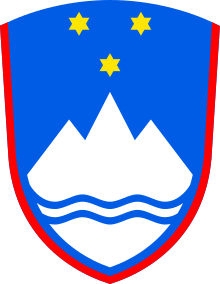
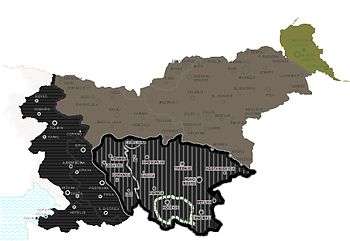
.jpg)
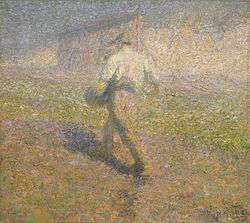
.svg.png)
